PPG and Bioimpedance-Based Wearable Applications in Heart Rate Monitoring—A Comprehensive Review
Abstract
1. Introduction
2. Methodology
2.1. Paper Selection Criteria
2.2. PPG, Bioimpedance, Heart Rate, Wearable Device
- Type of signals: papers providing a detailed overview on bioimpedance and PPG measurement as well as features extractable form PPG and bioimpedance signals.
- Signal processing: papers listing relevant signal pre-processing techniques, such as filtering and overall data cleaning were included.
- Algorithms: papers describing heart rate detection and motion artifact removal algorithms.
- Devices: wearable device technologies based on PPG and bioimpedance. Papers dealing with stationary bioimpedance analyzers were excluded from the selection of candidate papers.
- Devices: papers focusing on bioimpedance measurement with stationary analyzers which, by nature, are not wearable devices. Also, papers describing PPG measurement through a finger clip and not an actual wearable device were not included.
- Monitored parameter: papers with an emphasis on monitoring bioparameters other than the ones associated with heart rate were dismissed.
- Experiments on animals: papers dealing with various experiments on animals were not included.
3. Results
3.1. Article Selection Process
3.2. Analyzed Articles
3.3. Temporal Scope and Distribution
4. Biological Signals for Wearable-Based HR
4.1. Electrical Bioimpedance (EBI)
- Systolic phase—the left ventricle of the heart beats to push blood through the arteries and blood volume increases. Initial decrease in impedance.
- Diastolic phase—the heart rests between beats and blood volume leaves the sensing area. Impedance increases.
- The second, smaller impedance decrease due the arrival of the reflection wave.
- The final impedance increase as the reflected blood volume leaves the sensing area.
EBI Waveform Features for Cardiovascular Monitoring
- Amplitude features
- The peak amplitude
- The foot amplitude
- The total EBI amplitudewhere and are the amplitudes of a diastolic and systolic points, respectively, and is the amplitude of a point on the waveform corresponding to a maximum slope (further on referred to as a maximum slope point) between the diastolic and systolic peaks.
- Area features
- The area between the diastolic point and the maximum slope point
- The area between the maximum slope point and the systolic point
- The area between the diastolic and the systolic point
- Time features
- Slope transit time is the time difference between the systolic and diastolic points
- Inter-beat interval is the time difference between two consecutive diastolic pointswhere i denotes the i-th diastolic point.
- EBI Signal derivatives
4.2. Photoplethysmography
PPG Waveform Features
- Characteristic PPG waveform points
- Pulse wave transit time (PTT)
- Pulse wave arrival time (PAT)
- PPG Signal derivatives
5. Heart Rate Monitoring
5.1. Signal Pre-Processing
5.1.1. Sources of Noise
5.1.2. Noise Filtering
5.1.3. Motion Artifact Removal
- Without supplementary signals
- Sensitivity to noise in the recorded signals.
- Aliasing [9].
- Trend uncertainty [9].
- The method and its variations are based on empirical and heuristic procedures; thus, interpretability is its weakness [84].
- EMD and especially EEMD have a significant computational cost. A fast version of EEMD (FEEMD) was proposed in [85] lessening the computational burden of the original EEMD.
- With supplementary acceleration signals
- Low computation complexity allows for a real-time signal processing. The drawbacks are as follows [9]:
- The correlation between the reference signal and the motion spectrum has to be sufficiently high, which is impossible in practice.
- Very high computational requirements.
- Limitations
- The methods are too reliant on expertly tuned multiple parameters and heuristic thresholds, which prevents generalization [102].
- The commonly used acceleration signal in MA removal is not a direct MA source but is rather a superposition of movement of a body part and the gravitational acceleration [103]. Therefore, the recorded acceleration signals cannot be directly translated in to the movement of limbs during exercises.
5.2. Heart Rate Estimation
5.3. Algorithms
- TROIKA
- Signal decomposition: This part aims to denoise and sparsify the spectra of PPG signals. SSA helps to remove motion artifacts (MA) frequency components and to sparsify the spectrum coefficients. The time series is decomposed into oscillatory components and noise as shown below:
- Sparse signal reconstruction (SSR): SSR aims at obtaining the sparsest high-resolution spectrum of the PPG signal, which is robust against noise, using FOCUSS algorithms. This process is essential for distinguishing the heart rate component from other dominant frequencies caused by MAs. The basic model of SSR can be written as follows:Here, is a known basis matrix, the vector is the observed signal, is an unknown solution vector and is an unknown noise vector. The goal is to find the sparsest vector by minimizing the square of the norm of (−).
- Spectral peak tracking: The final step involves selecting and verifying the correct spectral peak corresponding to the heart rate. This involves an initialization phase where users are required to minimize motion, followed by the selection of spectral peaks within certain ranges, and a verification process that employs decision mechanisms to ensure the correct peak is chosen despite potential motion artifact interference.where is the location of spectral peak selected by the user, is the modified value based on the previous observations and = 6 and = 2 [103].
- JOSS
- Joint sparse signal recovery: Using the MMV model (multiple measurement vector), the spectra of the PPG signal and acceleration signals are jointly estimated. The MMV model provides unique solutions and better error performance compared to the SMV model (single measurement vector).
- Spectral subtraction: A simple spectral subtraction method is applied to remove the spectral peaks of MA from the PPG spectrum. The maximum values of spectral coefficients in the acceleration spectra are subtracted from the corresponding values in the PPG spectrum. Thresholding is then performed to zero out coefficients below a certain level.
- Spectral peak tracking: Compared to the TROIKA algorithm, a new phase of peak discovery is introduced. After the initialization of the peak, it is refined and validated based on previous estimates and the expected range of heart rate changes.
6. Wearable Devices for Heart Rate Monitoring
6.1. PPG-Based Devices
6.2. Bioimpedance-Based Devices
- Electrode–skin interface (see Section 5.1.1).
- Characteristics of the alternating current of excitation. The important parameters are the frequency [156] and amplitude of excitation current.
- The measured bioimpedance signal is affected by the type of tissues and the physiological and physiochemical variations that occur within the tissues [156].
- The difficulty of acquiring a signal of high enough quality due to:
- 1.1.
- Patient-related issues—spontaneous movements of the patient, micro-movements that are not controllable, disorders of heart rhythm [156]. Movement with an amplitude above a certain threshold may cause MAs severely degrading reliability of the estimated bioparameters.
- 1.2.
- Inherently low signal-to-noise ratio of the technique [157] thereby establishing a reliable, long-lasting and firm contact interface between the electrodes and the skin is of prime importance [18]. On a hardware/software level, signal pre-processing steps involving noise filtration with filters and algorithms is necessary. One solution of obtaining a signal with strength above a background noise is performing measurements of the systolic and diastolic impedance variations close to the ascending thoracic aorta [157]. This approach, however, is limited by the empirical nature and sensitivity to electrode positioning and calibration inherent in the method [158].
- Changes in the baseline impedance levels when direct comparisons to a healthy state are no longer valid due to physiologic and pathophysiologic conditions, such as pregnancy, obesity, gas or fluid pleural effusion, chronic congestive heart failure with pulmonary edema, or when there is severe aortic valve disease or modified mechanical properties of the arterial tree [157].
7. Discussion and Concluding Remarks
- PPG vs EBI. PPG-based devices are a comparatively mature technology with some commercial brands, while very few attempts have been made to design a wearable device for HR estimation based on EBI. However, compared to the PPG technology, devices based on EBI have the potential to provide a more accurate HR estimation due to the fact that skin tone affects properties of light absorption and reflection diminishing the reliability of PPG-based devices. On the other hand, wearable devices based on EBI face challenges related to power consumption and signal noise originating from a variety of sources including electromagnetic interference from electric circuitry, electrode size and material, levels of skin hydration and quality of contact between skin and surface of electrodes. Advances in flexible, self-adhesive materials have shown potential in enhancing sensor–skin contact, thereby improving signal quality. However, the integration of flexible substrates with rigid electronic components poses significant challenges, often leading to connection failures. Therefore, ongoing research into material science and engineering is vital to overcoming these hurdles. All in all, EBI-based devices have the potential to become mainstream once the electrode properties are carefully tailored to the general user.
- Design of wearable devices. The development of low-power consumption strategies, such as those employing multi-frequency EBI measurements and modifications in hardware design, for example, demodulation and current driver blocks, have been essential in extending the operational life of wearable devices. Despite these advancements, achieving a balance between power efficiency and high signal-to-noise ratio remains a critical area for further research and development. Until a breakthrough in power source development is achieved, the key question concerning wearable device progress is energy efficiency. The energy demand is primarily related to the computation complexity—a trade-off with edge computing, i.e., the speed of data representation and battery duration has to be considered. Solutions exist, in the form of analog edge computing-based machine learning [167], or relying on an analog circuit design [168].
- Motion artifact removal. Accurate HR estimation can easily be sabotaged by motion artifacts (MA). Various noise filtering and MA removal techniques have been employed to mitigate these issues, including band-pass filters and advanced algorithms that utilize supplementary signals for more precise correction. The algorithms most commonly employed in the literature include the ones based on signal decomposition—wavelet transform, empirical mode decomposition and Fourier decomposition. Then the user discards the components that are not related to the signal itself. Another group of methods is based on signal subtraction in the frequency domain (spectral subtraction). This approach, however, requires an estimation of heart rate frequency and detects deviations from it. This may pose a problem, since the assumption of a normal heart rate to be 1 Hz may not be generalized over all cases.
- Heart rate estimation. The mainstream algorithms for HR estimation are TROIKA and JOSS and others directly derived from these two. The reason is that these algorithms have proven to be fairly accurate and effective. Nonetheless, the implementation of TROIKA and JOSS into a wearable device is a challenging task, since these algorithms rely on heavy mathematical computations. Hence, the processing unit and, again, power consumption of the wearable device, pose challenges.
- Potential for a more complete hemodynamic monitoring. Apart from the HR estimation, PPG and EBI techniques have remarkable potential to also provide information on numerous other hemodynamic parameters. Such data, including the hemodynamic feature points, denoting, e.g., left ventricular ejection time (LVET) or pulse transit time (PTT), can be utilized already in performing prognostic and diagnostic tasks. However, for such operations, where the differentiation of the signal is performed, the signal quality is of paramount importance. Indeed, up to four derivatives of the PPG signal [169] and first derivative of EBI signal [170] have been studied in order to evaluate the heart and cardiovascular health.
Author Contributions
Funding
Acknowledgments
Conflicts of Interest
Abbreviations
| ACC | Accelerometer |
| ADC | Analog-to-Digital Converter |
| ADT | Adaptive Detection Threshold |
| ASIC | Application Specific Integrated Circuit |
| BioZ | Bioimpedance |
| BLE | Bluetooth Low Energy |
| BVP | Blood Volume Pulse |
| CVD | Cardiovascular disease |
| ECG | Electrocardiogram |
| EBI | Electrical Bioimpedance |
| EDA | Electrodermal Activity Sensor |
| EEMD | Extended Empirical Mode Decomposition |
| EMD | Empirical Mode Decomposition |
| FD | Fourier Decomposition |
| FIBF | Fourier Intrinsic Band Functions |
| GBP | Gain-Bandwidth Product |
| Gyro | Gyroscope |
| HR | Heart Rate |
| ICA | Independent Component Analysis |
| IMU | Inertial Measurement Unit |
| IoT | Internet of Things |
| IR | Infra Red |
| IIR | Infinite Impulse Response |
| LCD | Liquid Crystal Display |
| LED | Light-Emitting Diode |
| LSM | Least Mean Squares |
| LVET | Left Ventricular Ejection Time |
| MA | Moving Artifacts |
| MCU | Microcontrol Unit |
| MMV | Multiple Measurement Vector |
| NLSM | Normalized Least Mean Squares |
| NTC | Negative Temperature Coefficient Sensor |
| PCA | Principal Component Analysis |
| PAT | Pulse Arrival Time |
| PCB | Printed Circuit Board |
| PPG | Photoplethysmography |
| PTT | Pulse wave Transit Time |
| RLS | Recursive Least Squares |
| SMV | Single Measurement Vector |
| SNR | Signal-to-Noise Ratio |
| SoC | System On Chip |
| SS | Spectral Subtraction |
| SSR | Sparse Signal Reconstruction |
| Term | Thermometer |
| Tempe | Temperature |
| WT | Wavelet Transform |
References
- Cardiovascular Diseases. 2021. Available online: https://www.who.int/health-topics/cardiovascular-diseases/#tab=tab_1 (accessed on 23 July 2024).
- Cardiovascular Diseases (CVDs). 2021. Available online: https://www.who.int/en/news-room/fact-sheets/detail/cardiovascular-diseases-(cvds) (accessed on 23 July 2024).
- Umer, M.; Aljrees, T.; Karamti, H.; Ishaq, A.; Alsubai, S.; Omar, M.; Bashir, A.K.; Ashraf, I. Heart failure patients monitoring using IoT-based remote monitoring system. Sci. Rep. 2023, 13, 19213. [Google Scholar] [CrossRef] [PubMed]
- Chatzopoulos, G.S.; Jiang, Z.; Marka, N.; Wolff, L.F. Periodontal disease, tooth loss, and systemic conditions: An exploratory study. Int. Dent. J. 2024, 74, 207–215. [Google Scholar] [CrossRef]
- Hershman, S.G.; Bot, B.M.; Shcherbina, A.; Doerr, M.; Moayedi, Y.; Pavlovic, A.; Waggott, D.; Cho, M.K.; Rosenberger, M.E.; Haskell, W.L.; et al. Physical activity, sleep and cardiovascular health data for 50,000 individuals from the MyHeart Counts Study. Sci. Data 2019, 6, 24. [Google Scholar] [CrossRef]
- Williams, G.J.; Al-Baraikan, A.; Rademakers, F.E.; Ciravegna, F.; van de Vosse, F.N.; Lawrie, A.; Rothman, A.; Ashley, E.A.; Wilkins, M.R.; Lawford, P.V.; et al. Wearable technology and the cardiovascular system: The future of patient assessment. Lancet Digit. Health 2023, 5, e467–e476. [Google Scholar] [CrossRef]
- Maiorana, E. A survey on biometric recognition using wearable devices. Pattern Recognit. Lett. 2022, 156, 29–37. [Google Scholar] [CrossRef]
- Babar, M.; Rahman, A.; Arif, F.; Jeon, G. Energy-harvesting based on internet of things and big data analytics for smart health monitoring. Sustain. Comput. Inform. Syst. 2018, 20, 155–164. [Google Scholar] [CrossRef]
- Kumar, A.; Komaragiri, R.; Kumar, M. Reference signal less Fourier analysis based motion artifact removal algorithm for wearable photoplethysmography devices to estimate heart rate during physical exercises. Comput. Biol. Med. 2022, 141, 105081. [Google Scholar]
- Shcherbina, A.; Mattsson, C.M.; Waggott, D.; Salisbury, H.; Christle, J.W.; Hastie, T.; Wheeler, M.T.; Ashley, E.A. Accuracy in wrist-worn, sensor-based measurements of heart rate and energy expenditure in a diverse cohort. J. Pers. Med. 2017, 7, 3. [Google Scholar] [CrossRef] [PubMed]
- Teng, X.F.; Zhang, Y.T.; Poon, C.C.; Bonato, P. Wearable medical systems for p-health. IEEE Rev. Biomed. Eng. 2008, 1, 62–74. [Google Scholar] [CrossRef]
- Martinsen, O.G.; Heiskanen, A. Bioimpedance and Bioelectricity Basics; Elsevier: Amsterdam, The Netherlands, 2023. [Google Scholar]
- Dheman, K.; Mayer, P.; Eggimann, M.; Schuerle, S.; Magno, M. ImpediSense: A long lasting wireless wearable bio-impedance sensor node. Sustain. Comput. Inform. Syst. 2021, 30, 100556. [Google Scholar]
- Rossi, S.; Pessione, M.; Radicioni, V.; Baglione, G.; Vatteroni, M.; Dario, P.; Della Torre, L. A low power bioimpedance module for wearable systems. Sensors Actuators A Phys. 2015, 232, 359–367. [Google Scholar] [CrossRef]
- Tronstad, C.; Elvebakk, O.; Staal, O.M.; Kalvøy, H.; Høgetveit, J.O.; Jenssen, T.G.; Birkeland, K.I.; Martinsen, Ø.G. Non-invasive prediction of blood glucose trends during hypoglycemia. Anal. Chim. Acta 2019, 1052, 37–48. [Google Scholar] [CrossRef]
- Alharbi, Y.; Alshrouf, A.; Mansouri, S. Heart rate monitoring using electrical impedance. In Proceedings of the 2021 Seventh International conference on Bio Signals, Images, and Instrumentation (ICBSII), Chennai, India, 25–27 March 2021; pp. 1–4. [Google Scholar]
- GmbH, M.M. Impedance Cardiography (ICG). Available online: https://www.medis.company/en/methods/impedance-cardiography (accessed on 13 July 2024).
- Sel, K.; Osman, D.; Huerta, N.; Edgar, A.; Pettigrew, R.I.; Jafari, R. Continuous cuffless blood pressure monitoring with a wearable ring bioimpedance device. Npj Digit. Med. 2023, 6, 59. [Google Scholar] [CrossRef]
- Redisch, W. Electrical impedance plethysmography. Chest 1971, 59, 36. [Google Scholar] [CrossRef]
- Cheney, M.; Isaacson, D.; Newell, J.C. Electrical impedance tomography. SIAM Rev. 1999, 41, 85–101. [Google Scholar] [CrossRef]
- Baumgartner, R.N.; Chumlea, W.C.; Roche, A.F. Bioelectric impedance phase angle and body composition. Am. J. Clin. Nutr. 1988, 48, 16–23. [Google Scholar] [CrossRef]
- Bernstein, D.P. Continuous noninvasive real-time monitoring of stroke volume and cardiac output by thoracic electrical bioimpedance. Crit. Care Med. 1986, 14, 898–901. [Google Scholar] [CrossRef]
- Poon, C.; Chung, Y.; Choy, T.; Pang, J. Evaluation of two noninvasive techniques for exercise ventilatory measurements. In Proceedings of the Annual International Conference of the IEEE Engineering in Medicine and Biology Society, New Orleans, LA, USA, 4–7 November 1988; pp. 823–824. [Google Scholar]
- Thangathurai, D.; Charbonnet, C.; Roessler, P.; Wo, C.C.; Mikhail, M.; Yoshida, R.; Shoemaker, W.C. Continuous intraoperative noninvasive cardiac output monitoring using a new thoracic bioimpedance device. J. Cardiothorac. Vasc. Anesth. 1997, 11, 440–444. [Google Scholar] [CrossRef]
- Wang, F.T.; Chan, H.L.; Wang, C.L.; Jian, H.M.; Lin, S.H. Instantaneous respiratory estimation from thoracic impedance by empirical mode decomposition. Sensors 2015, 15, 16372–16387. [Google Scholar] [CrossRef]
- Piuzzi, E.; Capuano, A.; Pisa, S.; Cappa, P.; Patané, F.; Rossi, S.; Giaquinto, N.; D’Aucelli, G.M. Impedance plethysmography system with inertial measurement units for motion artefact reduction: Application to continuous breath activity monitoring. In Proceedings of the 2015 IEEE International Symposium on Medical Measurements and Applications (MeMeA) Proceedings, Turin, Italy, 7–9 May 2015; pp. 386–390. [Google Scholar]
- Luna-Lozano, P.S.; García-Zetina, O.A.; Pérez-López, J.A.; Alvarado-Serrano, C. Portable device for heart rate monitoring based on impedance pletysmography. In Proceedings of the 2014 11th International Conference on Electrical Engineering, Computing Science and Automatic Control (CCE), Ciudad del Carmen, Mexico, 29 September–3 October 2014; pp. 1–4. [Google Scholar]
- Metshein, M. A device for measuring the electrical bioimpedance with variety of electrode placements for monitoring the breathing and heart rate. In Proceedings of the 2015 26th Irish Signals and Systems Conference (ISSC), Carlow, Ireland, 24–25 June 2015; pp. 1–4. [Google Scholar]
- Pittella, E.; Pisa, S.; Piuzzi, E.; Rizzuto, E.; Del Prete, Z. Combined impedance plethysmography and spectroscopy for the diagnosis of diseases of peripheral vascular system. In Proceedings of the 2017 IEEE International Symposium on Medical Measurements and Applications (MeMeA), Rochester, MN, USA, 7–10 May 2017; pp. 367–372. [Google Scholar]
- Irzmańska, E.; Padula, G.; Irzmański, R. Impedance plethysmography as a tool for assessing exertion-related blood flow changes in the lower limbs in healthy subjects. Measurement 2014, 47, 110–115. [Google Scholar] [CrossRef]
- Huynh, T.H.; Jafari, R.; Chung, W.Y. An accurate bioimpedance measurement system for blood pressure monitoring. Sensors 2018, 18, 2095. [Google Scholar] [CrossRef] [PubMed]
- Patterson, R. Fundamentals of impedance cardiography. IEEE Eng. Med. Biol. Mag. 1989, 8, 35–38. [Google Scholar] [CrossRef]
- Yazdanian, H.; Mahnam, A.; Edrisi, M.; Esfahani, M. Design and Implementation of a Portable Impedance Cardiography System for Noninvasive Stroke Volume Monitoring. J. Med. Signals Sens. 2016, 6, 47–56. [Google Scholar] [CrossRef]
- Ming, D.K.; Sangkaew, S.; Chanh, H.Q.; Nhat, P.T.; Yacoub, S.; Georgiou, P.; Holmes, A.H. Continuous physiological monitoring using wearable technology to inform individual management of infectious diseases, public health and outbreak responses. Int. J. Infect. Dis. 2020, 96, 648–654. [Google Scholar] [CrossRef] [PubMed]
- Tamura, T. Current progress of photoplethysmography and SPO2 for health monitoring. Biomed. Eng. Lett. 2019, 9, 21–36. [Google Scholar] [CrossRef]
- Shin, H.S.; Lee, C.; Lee, M. Adaptive threshold method for the peak detection of photoplethysmographic waveform. Comput. Biol. Med. 2009, 39, 1145–1152. [Google Scholar] [CrossRef]
- Xiaotian, M.; Guo, R.; Zhang, C.; Yan, J.; Zhu, G.; Wu, W.; Yan, H.; Hong, L. An innovative approach for assessing coronary artery lesions: Fusion of wrist pulse and photoplethysmography using a multi-sensor pulse diagnostic device. Heliyon 2024, 10. [Google Scholar] [CrossRef]
- Yadav, U.; Abbas, S.N.; Hatzinakos, D. Evaluation of PPG biometrics for authentication in different states. In Proceedings of the 2018 International Conference on Biometrics (ICB), Gold Coast, QLD, Australia, 20–23 February 2018; pp. 277–282. [Google Scholar]
- Donida Labati, R.; Piuri, V.; Rundo, F.; Scotti, F.; Spampinato, C. Biometric recognition of PPG cardiac signals using transformed spectrogram images. In Proceedings of the International Conference on Pattern Recognition, Virtual, 10–11 January 2021; Springer: Cham, Switzerland, 2021; pp. 244–257. [Google Scholar]
- Hwang, D.Y.; Taha, B.; Lee, D.S.; Hatzinakos, D. Evaluation of the time stability and uniqueness in PPG-based biometric system. IEEE Trans. Inf. Forensics Secur. 2020, 16, 116–130. [Google Scholar] [CrossRef]
- Moço, A.V.; Stuijk, S.; De Haan, G. New insights into the origin of remote PPG signals in visible light and infrared. Sci. Rep. 2018, 8, 8501. [Google Scholar] [CrossRef]
- Radha, M.; Fonseca, P.; Moreau, A.; Ross, M.; Cerny, A.; Anderer, P.; Long, X.; Aarts, R.M. A deep transfer learning approach for wearable sleep stage classification with photoplethysmography. NPJ Digit. Med. 2021, 4, 135. [Google Scholar] [CrossRef]
- Castaneda, D.; Esparza, A.; Ghamari, M.; Soltanpur, C.; Nazeran, H. A review on wearable photoplethysmography sensors and their potential future applications in health care. Int. J. Biosens. Bioelectron. 2018, 4, 195. [Google Scholar]
- Cao, Y.; Zhang, Q.; Li, F.; Yang, S.; Wang, Y. PPGPass: Nonintrusive and secure mobile two-factor authentication via wearables. In Proceedings of the IEEE INFOCOM 2020-IEEE Conference on Computer Communications, Toronto, ON, Canada, 6–9 July 2020; pp. 1917–1926. [Google Scholar]
- Buekers, J.; Theunis, J.; De Boever, P.; Vaes, A.W.; Koopman, M.; Janssen, E.V.; Wouters, E.F.; Spruit, M.A.; Aerts, J.M. Wearable finger pulse oximetry for continuous oxygen saturation measurements during daily home routines of patients with chronic obstructive pulmonary disease (COPD) over one week: Observational study. JMIR MHealth UHealth 2019, 7, e12866. [Google Scholar] [CrossRef]
- Ekiz, D.; Can, Y.S.; Dardağan, Y.C.; Aydar, F.; Köse, R.D.; Ersoy, C. End-to-end deep multi-modal physiological authentication with smartbands. IEEE Sens. J. 2021, 21, 14977–14986. [Google Scholar] [CrossRef]
- Davies, H.J.; Bachtiger, P.; Williams, I.; Molyneaux, P.L.; Peters, N.S.; Mandic, D.P. Wearable in-ear PPG: Detailed respiratory variations enable classification of COPD. IEEE Trans. Biomed. Eng. 2022, 69, 2390–2400. [Google Scholar] [CrossRef] [PubMed]
- Loh, H.W.; Xu, S.; Faust, O.; Ooi, C.P.; Barua, P.D.; Chakraborty, S.; Tan, R.S.; Molinari, F.; Acharya, U.R. Application of photoplethysmography signals for healthcare systems: An in-depth review. Comput. Methods Programs Biomed. 2022, 216, 106677. [Google Scholar] [CrossRef] [PubMed]
- Allen, J. Photoplethysmography and its application in clinical physiological measurement. Physiol. Meas. 2007, 28, R1. [Google Scholar] [CrossRef] [PubMed]
- Vhaduri, S.; Poellabauer, C. Summary: Multi-modal biometric-based implicit authentication of wearable device users. arXiv 2019, arXiv:1907.06563. [Google Scholar]
- Nishan, A.; Raju, S.T.U.; Hossain, M.I.; Dipto, S.A.; Uddin, S.T.; Sijan, A.; Chowdhury, M.A.S.; Ahmad, A.; Khan, M.M.H. A continuous cuffless blood pressure measurement from optimal PPG characteristic features using machine learning algorithms. Heliyon 2024, 10. [Google Scholar] [CrossRef]
- Ding, X.R.; Zhang, Y.T.; Liu, J.; Dai, W.X.; Tsang, H.K. Continuous cuffless blood pressure estimation using pulse transit time and photoplethysmogram intensity ratio. IEEE Trans. Biomed. Eng. 2015, 63, 964–972. [Google Scholar] [CrossRef]
- Mohanalakshmi, S.; Sivasubramanian, A.; Swarnalatha, A. Predicting arterial stiffness from physiological characteristics of photoplethysmography signals quantified through second derivative. Indian J. Sci. Technol. 2017, 10, 104111. [Google Scholar] [CrossRef]
- Lee, J.; Kim, M.; Park, H.K.; Kim, I.Y. Motion Artifact Reduction in Wearable Photoplethysmography Based on Multi-Channel Sensors with Multiple Wavelengths. Sensors 2020, 20, 1493. [Google Scholar] [CrossRef] [PubMed]
- Liu, Z.J.; Xiang, T.; Zhou, R.S.; Ji, N.; Zhang, Y.T. A Multi-Channel Photoplethysmography Array with Contact-Force Regulation for Tonoarteriographic Imaging. Connect. Health Telemed. 2024, 3, 300001. [Google Scholar] [CrossRef]
- Cömert, A.; Hyttinen, J. Investigating the Possible Effect of Electrode Support Structure on Motion Artifact in Wearable Bioelectric Signal Monitoring. BioMed Eng. OnLine 2015, 14, 44. [Google Scholar] [CrossRef]
- Kõiv, H.; Pesti, K.; Min, M.; Land, R.; Must, I. Comparison of the Carbon Nanofiber-/Fiber- and Silicone-Based Electrodes for Bioimpedance Measurements. IEEE Trans. Instrum. Meas. 2020, 69, 1455–1463. [Google Scholar] [CrossRef]
- Dheman, K.; Mayer, P.; Magno, M.; Schuerle, S. Wireless, Artefact Aware Impedance Sensor Node for Continuous Bio-Impedance Monitoring. IEEE Trans. Biomed. Circuits Syst. 2020, 14, 1122–1134. [Google Scholar] [CrossRef] [PubMed]
- McAdams, E.; Jossinet, J.; Lacketmeier, A.; Risacher, F. Factors Affecting Electrode-Gel-Skin Interface Impedance in Electrical Impedance Tomography. Med. Biol. Eng. Comput. 1996, 34, 397–408. [Google Scholar] [CrossRef]
- Huang, J.; Zhang, Y.; Wu, J. Review of non-invasive continuous glucose monitoring based on impedance spectroscopy. Sens. Actuators A Phys. 2020, 311, 112103. [Google Scholar] [CrossRef]
- Lapsa, D.; Janeliukštis, R.; Elsts, A. Electrode Comparison for Heart Rate Detection via Bioimpedance Measurements. In Proceedings of the 2022 Workshop on Microwave Theory and Techniques in Wireless Communications (MTTW), Riga, Latvia, 5–7 October 2022; pp. 41–46. [Google Scholar]
- Sel, K.; Kireev, D.; Brown, A.; Ibrahim, B.; Akinwande, D.; Jafari, R. Electrical characterization of graphene-based e-tattoos for bio-impedance-based physiological sensing. In Proceedings of the 2019 IEEE Biomedical Circuits and Systems Conference (BioCAS), Nara, Japan, 17–19 October 2019; pp. 1–4. [Google Scholar]
- Kabiri Ameri, S.; Ho, R.; Jang, H.; Tao, L.; Wang, Y.; Wang, L.; Schnyer, D.M.; Akinwande, D.; Lu, N. Graphene electronic tattoo sensors. ACS Nano 2017, 11, 7634–7641. [Google Scholar] [CrossRef]
- Sel, K.; Brown, A.; Jang, H.; Krumholz, H.M.; Lu, N.; Jafari, R. A wrist-worn respiration monitoring device using bio-impedance. In Proceedings of the 2020 42nd Annual International Conference of the IEEE Engineering in Medicine & Biology Society (EMBC), Montreal, QC, Canada, 20–24 July 2020; pp. 3989–3993. [Google Scholar]
- Campetelli, G.; Zumoffen, D.; Basualdo, M. Improvements on noninvasive blood glucose biosensors using wavelets for quick fault detection. J. Sens. 2011, 2011, 368015. [Google Scholar] [CrossRef]
- Metshein, M.; Annus, P.; Land, R.; Min, M.; Aabloo, A. Availability and variations of cardiac activity in the case of measuring the bioimpedance of wrist. In Proceedings of the 2018 IEEE International Instrumentation and Measurement Technology Conference (I2MTC), Houston, TX, USA, 14–17 May 2018; pp. 1–5. [Google Scholar]
- Metshein, M.; Pesti, K.; Lapsa, D.; Annus, P.; Janeliukstis, R.; Elsts, A.; Martens, O. Evaluation of Two-Electrode System Configurations for Forearm Arteries Bioimpedance Measurement. In Proceedings of the 2024 IEEE International Instrumentation and Measurement Technology Conference (I2MTC), Glasgow, UK, 20–23 May 2024; pp. 1–6. [Google Scholar] [CrossRef]
- Sun, B.; Wang, C.; Chen, X.; Zhang, Y.; Shao, H. PPG signal motion artifacts correction algorithm based on feature estimation. Optik 2019, 176, 337–349. [Google Scholar] [CrossRef]
- Zhang, Y.; Liu, B.; Zhang, Z. Combining ensemble empirical mode decomposition with spectrum subtraction technique for heart rate monitoring using wrist-type photoplethysmography. Biomed. Signal Process. Control 2015, 21, 119–125. [Google Scholar] [CrossRef]
- Albaba, A.; Castro, I.; Borzée, P.; Buyse, B.; Testelmans, D.; Varon, C.; Van Huffel, S.; Torfs, T. Automatic quality assessment of capacitively-coupled bioimpedance signals for respiratory activity monitoring. Biomed. Signal Process. Control 2021, 68, 102775. [Google Scholar] [CrossRef]
- Wang, L.; Liu, S.; Li, G.; Zhu, R. Interface sensors with skin piezo-thermic transduction enable motion artifact removal for wearable physiological monitoring. Biosens. Bioelectron. 2021, 188, 113325. [Google Scholar] [CrossRef] [PubMed]
- Lee, H.; Chung, H.; Ko, H.; Parisi, A.; Busacca, A.; Faes, L.; Pernice, R.; Lee, J. Adaptive scheduling of acceleration and gyroscope for motion artifact cancelation in photoplethysmography. Comput. Methods Programs Biomed. 2022, 226, 107126. [Google Scholar] [CrossRef]
- Kim, B.S.; Yoo, S.K. Motion artifact reduction in photoplethysmography using independent component analysis. IEEE Trans. Biomed. Eng. 2006, 53, 566–568. [Google Scholar] [CrossRef]
- Krishnan, R.; Natarajan, B.; Warren, S. Two-stage approach for detection and reduction of motion artifacts in photoplethysmographic data. IEEE Trans. Biomed. Eng. 2010, 57, 1867–1876. [Google Scholar] [CrossRef] [PubMed]
- Peng, F.; Zhang, Z.; Gou, X.; Liu, H.; Wang, W. Motion artifact removal from photoplethysmographic signals by combining temporally constrained independent component analysis and adaptive filter. Biomed. Eng. Online 2014, 13, 1–14. [Google Scholar] [CrossRef]
- Chen, W.; Jaques, N.; Taylor, S.; Sano, A.; Fedor, S.; Picard, R.W. Wavelet-based motion artifact removal for electrodermal activity. In Proceedings of the 2015 37th Annual International Conference of the IEEE Engineering in Medicine and Biology Society (EMBC), Milan, Italy, 25–29 August 2015; pp. 6223–6226. [Google Scholar]
- Huang, N.E.; Shen, Z.; Long, S.R.; Wu, M.C.; Shih, H.H.; Zheng, Q.; Yen, N.C.; Tung, C.C.; Liu, H.H. The empirical mode decomposition and the Hilbert spectrum for nonlinear and non-stationary time series analysis. Proc. R. Soc. Lond. Ser. A Math. Phys. Eng. Sci. 1998, 454, 903–995. [Google Scholar] [CrossRef]
- Lee, J.; McManus, D.D.; Merchant, S.; Chon, K.H. Automatic motion and noise artifact detection in Holter ECG data using empirical mode decomposition and statistical approaches. IEEE Trans. Biomed. Eng. 2011, 59, 1499–1506. [Google Scholar]
- Komaty, A.; Boudraa, A.O.; Augier, B.; Daré-Emzivat, D. EMD-based filtering using similarity measure between probability density functions of IMFs. IEEE Trans. Instrum. Meas. 2013, 63, 27–34. [Google Scholar] [CrossRef]
- Garde, A.; Karlen, W.; Dehkordi, P.; Ansermino, J.M.; Dumont, G.A. Empirical mode decomposition for respiratory and heart rate estimation from the photoplethysmogram. In Proceedings of the Computing in Cardiology 2013, Zaragoza, Spain, 22–25 September 2013; pp. 799–802. [Google Scholar]
- Wang, Q.; Yang, P.; Zhang, Y. Artifact reduction based on Empirical Mode Decomposition (EMD) in photoplethysmography for pulse rate detection. In Proceedings of the 2010 Annual International Conference of the IEEE Engineering in Medicine and Biology, Buenos Aires, Argentina, 31 August–4 September 2010; pp. 959–962. [Google Scholar]
- Khan, E.; Al Hossain, F.; Uddin, S.Z.; Alam, S.K.; Hasan, M.K. A robust heart rate monitoring scheme using photoplethysmographic signals corrupted by intense motion artifacts. IEEE Trans. Biomed. Eng. 2015, 63, 550–562. [Google Scholar] [CrossRef]
- Wu, Z.; Huang, N.E. Ensemble empirical mode decomposition: A noise-assisted data analysis method. Adv. Adapt. Data Anal. 2009, 1, 1–41. [Google Scholar] [CrossRef]
- Singh, P.; Joshi, S.D.; Patney, R.K.; Saha, K. The Fourier decomposition method for nonlinear and non-stationary time series analysis. Proc. R. Soc. A Math. Phys. Eng. Sci. 2017, 473, 20160871. [Google Scholar] [CrossRef]
- Wang, Y.H.; Yeh, C.H.; Young, H.W.V.; Hu, K.; Lo, M.T. On the computational complexity of the empirical mode decomposition algorithm. Phys. A Stat. Mech. Its Appl. 2014, 400, 159–167. [Google Scholar] [CrossRef]
- Lee, H.; Chung, H.; Lee, J. Motion artifact cancellation in wearable photoplethysmography using gyroscope. IEEE Sens. J. 2018, 19, 1166–1175. [Google Scholar] [CrossRef]
- Lee, H.; Chung, H.; Kim, J.W.; Lee, J. Motion artifact identification and removal from wearable reflectance photoplethysmography using piezoelectric transducer. IEEE Sens. J. 2019, 19, 3861–3870. [Google Scholar] [CrossRef]
- Lee, H.; Chung, H.; Ko, H.; Lee, J. Wearable multichannel photoplethysmography framework for heart rate monitoring during intensive exercise. IEEE Sens. J. 2018, 18, 2983–2993. [Google Scholar] [CrossRef]
- Poh, M.Z.; Swenson, N.C.; Picard, R.W. Motion-tolerant magnetic earring sensor and wireless earpiece for wearable photoplethysmography. IEEE Trans. Inf. Technol. Biomed. 2010, 14, 786–794. [Google Scholar] [CrossRef]
- Yousefi, R.; Nourani, M.; Ostadabbas, S.; Panahi, I. A motion-tolerant adaptive algorithm for wearable photoplethysmographic biosensors. IEEE J. Biomed. Health Inform. 2013, 18, 670–681. [Google Scholar] [CrossRef]
- Ye, Y.; Cheng, Y.; He, W.; Hou, M.; Zhang, Z. Combining nonlinear adaptive filtering and signal decomposition for motion artifact removal in wearable photoplethysmography. IEEE Sens. J. 2016, 16, 7133–7141. [Google Scholar] [CrossRef]
- Arunkumar, K.; Bhaskar, M. Heart rate estimation from photoplethysmography signal for wearable health monitoring devices. Biomed. Signal Process. Control 2019, 50, 1–9. [Google Scholar]
- Tanaka, H.; Monahan, K.D.; Seals, D.R. Age-predicted maximal heart rate revisited. J. Am. Coll. Cardiol. 2001, 37, 153–156. [Google Scholar] [CrossRef]
- Gellish, R.L.; Goslin, B.R.; Olson, R.E.; McDONALD, A.; Russi, G.D.; Moudgil, V.K. Longitudinal modeling of the relationship between age and maximal heart rate. Med. Sci. Sports Exerc. 2007, 39, 822–829. [Google Scholar] [CrossRef] [PubMed]
- Nitzan, M.; Faib, I.; Friedman, H. Respiration-induced changes in tissue blood volume distal to occluded artery, measured by photoplethysmography. J. Biomed. Opt. 2006, 11, 040506. [Google Scholar] [CrossRef] [PubMed]
- Yasuma, F.; Hayano, J.i. Respiratory sinus arrhythmia: Why does the heartbeat synchronize with respiratory rhythm? Chest 2004, 125, 683–690. [Google Scholar] [CrossRef]
- Xu, L.; Zhang, D.; Wang, K.; Li, N.; Wang, X. Baseline wander correction in pulse waveforms using wavelet-based cascaded adaptive filter. Comput. Biol. Med. 2007, 37, 716–731. [Google Scholar] [CrossRef]
- Lu, S.; Zhao, H.; Ju, K.; Shin, K.; Lee, M.; Shelley, K.; Chon, K.H. Can photoplethysmography variability serve as an alternative approach to obtain heart rate variability information? J. Clin. Monit. Comput. 2008, 22, 23–29. [Google Scholar] [CrossRef] [PubMed]
- Fukushima, H.; Kawanaka, H.; Bhuiyan, M.S.; Oguri, K. Estimating heart rate using wrist-type photoplethysmography and acceleration sensor while running. In Proceedings of the 2012 Annual International Conference of the IEEE Engineering in Medicine and Biology Society, San Diego, CA, USA, 28 August –1 September 2012; pp. 2901–2904. [Google Scholar]
- Sun, B.; Zhang, Z. Photoplethysmography-based heart rate monitoring using asymmetric least squares spectrum subtraction and bayesian decision theory. IEEE Sens. J. 2015, 15, 7161–7168. [Google Scholar] [CrossRef]
- Motin, M.A.; Karmakar, C.K.; Palaniswami, M. Ensemble empirical mode decomposition with principal component analysis: A novel approach for extracting respiratory rate and heart rate from photoplethysmographic signal. IEEE J. Biomed. Health Informatics 2017, 22, 766–774. [Google Scholar] [CrossRef]
- Biswas, D.; Everson, L.; Liu, M.; Panwar, M.; Verhoef, B.E.; Patki, S.; Kim, C.H.; Acharyya, A.; Van Hoof, C.; Konijnenburg, M.; et al. CorNET: Deep learning framework for PPG-based heart rate estimation and biometric identification in ambulant environment. IEEE Trans. Biomed. Circuits Syst. 2019, 13, 282–291. [Google Scholar] [CrossRef]
- Zhang, Z.; Pi, Z.; Liu, B. TROIKA: A general framework for heart rate monitoring using wrist-type photoplethysmographic signals during intensive physical exercise. IEEE Trans. Biomed. Eng. 2014, 62, 522–531. [Google Scholar] [CrossRef]
- Ershad, F.; Thukral, A.; Yue, J.; Comeaux, P.; Lu, Y.; Shim, H.; Sim, K.; Kim, N.I.; Rao, Z.; Guevara, R.; et al. Ultra-conformal drawn-on-skin electronics for multifunctional motion artifact-free sensing and point-of-care treatment. Nat. Commun. 2020, 11, 3823. [Google Scholar] [CrossRef] [PubMed]
- Kwon, S.; Kwon, Y.T.; Kim, Y.S.; Lim, H.R.; Mahmood, M.; Yeo, W.H. Skin-conformal, soft material-enabled bioelectronic system with minimized motion artifacts for reliable health and performance monitoring of athletes. Biosens. Bioelectron. 2020, 151, 111981. [Google Scholar] [CrossRef]
- Gruetzmann, A.; Hansen, S.; Müller, J. Novel dry electrodes for ECG monitoring. Physiol. Meas. 2007, 28, 1375. [Google Scholar] [CrossRef] [PubMed]
- Zhang, Z. Photoplethysmography-based heart rate monitoring in physical activities via joint sparse spectrum reconstruction. IEEE Trans. Biomed. Eng. 2015, 62, 1902–1910. [Google Scholar] [CrossRef] [PubMed]
- Temko, A. Accurate heart rate monitoring during physical exercises using PPG. IEEE Trans. Biomed. Eng. 2017, 64, 2016–2024. [Google Scholar] [CrossRef]
- Fujita, Y.; Hiromoto, M.; Sato, T. PARHELIA: Particle filter-based heart rate estimation from photoplethysmographic signals during physical exercise. IEEE Trans. Biomed. Eng. 2017, 65, 189–198. [Google Scholar] [CrossRef]
- Nathan, V.; Jafari, R. Particle filtering and sensor fusion for robust heart rate monitoring using wearable sensors. IEEE J. Biomed. Health Inform. 2017, 22, 1834–1846. [Google Scholar] [CrossRef]
- Lee, J.; Chung, H.; Lee, H. Multi-mode particle filtering methods for heart rate estimation from wearable photoplethysmography. IEEE Trans. Biomed. Eng. 2019, 66, 2789–2799. [Google Scholar] [CrossRef]
- Chung, H.; Lee, H.; Lee, J. Finite state machine framework for instantaneous heart rate validation using wearable photoplethysmography during intensive exercise. IEEE J. Biomed. Health Inform. 2018, 23, 1595–1606. [Google Scholar] [CrossRef]
- Reiss, A.; Indlekofer, I.; Schmidt, P.; Van Laerhoven, K. Deep PPG: Large-scale heart rate estimation with convolutional neural networks. Sensors 2019, 19, 3079. [Google Scholar] [CrossRef] [PubMed]
- Biswas, D.; Simões-Capela, N.; Van Hoof, C.; Van Helleputte, N. Heart rate estimation from wrist-worn photoplethysmography: A review. IEEE Sens. J. 2019, 19, 6560–6570. [Google Scholar] [CrossRef]
- Wójcikowski, M.; Pankiewicz, B. Photoplethysmographic time-domain heart rate measurement algorithm for resource-constrained wearable devices and its implementation. Sensors 2020, 20, 1783. [Google Scholar] [CrossRef] [PubMed]
- Chung, H.; Lee, H.; Lee, J. State-dependent Gaussian kernel-based power spectrum modification for accurate instantaneous heart rate estimation. PLoS ONE 2019, 14, e0215014. [Google Scholar] [CrossRef]
- Blasco, J.; Peris-Lopez, P. On the feasibility of low-cost wearable sensors for multi-modal biometric verification. Sensors 2018, 18, 2782. [Google Scholar] [CrossRef]
- Griswold-Steiner, I.; Matovu, R.; Serwadda, A. Wearables-driven freeform handwriting authentication. IEEE Trans. Biom. Behav. Identity Sci. 2019, 1, 152–164. [Google Scholar] [CrossRef]
- Retsinas, G.; Filntisis, P.P.; Efthymiou, N.; Theodosis, E.; Zlatintsi, A.; Maragos, P. Person identification using deep convolutional neural networks on short-term signals from wearable sensors. In Proceedings of the ICASSP 2020-2020 IEEE International Conference on Acoustics, Speech and Signal Processing (ICASSP), Barcelona, Spain, 4–8 May 2020; pp. 3657–3661. [Google Scholar]
- Oppel, E.; Kamann, S.; Reichl, F.X.; Högg, C. The Dexcom glucose monitoring system—An isobornyl acrylate-free alternative for diabetic patients. Contact Dermat. 2019, 81, 32–36. [Google Scholar] [CrossRef]
- Ouyang, H.; Tian, J.; Sun, G.; Zou, Y.; Liu, Z.; Li, H.; Zhao, L.; Shi, B.; Fan, Y.; Fan, Y.; et al. Self-powered pulse sensor for antidiastole of cardiovascular disease. Adv. Mater. 2017, 29, 1703456. [Google Scholar] [CrossRef]
- Schäfer, A.; Vagedes, J. How accurate is pulse rate variability as an estimate of heart rate variability?: A review on studies comparing photoplethysmographic technology with an electrocardiogram. Int. J. Cardiol. 2013, 166, 15–29. [Google Scholar] [CrossRef]
- Wang, W.F.; Yang, C.Y.; Wu, Y.F. SVM-based classification method to identify alcohol consumption using ECG and PPG monitoring. Pers. Ubiquitous Comput. 2018, 22, 275–287. [Google Scholar] [CrossRef]
- Hwang, S.; Seo, J.; Jebelli, H.; Lee, S. Feasibility analysis of heart rate monitoring of construction workers using a photoplethysmography (PPG) sensor embedded in a wristband-type activity tracker. Autom. Constr. 2016, 71, 372–381. [Google Scholar] [CrossRef]
- Kim, Y.J.; Jang, H.S.; Byun, C.S.; Choi, B.S. Development of u-health monitoring system using PPG sensor. In Proceedings of the 2018 International Conference on Electronics, Information, and Communication (ICEIC), Honolulu, HI, USA, 24–27 January 2018; pp. 1–2. [Google Scholar]
- Wannenburg, J.; Malekian, R. Body sensor network for mobile health monitoring, a diagnosis and anticipating system. IEEE Sens. J. 2015, 15, 6839–6852. [Google Scholar] [CrossRef]
- Carek, A.M.; Inan, O.T. Robust sensing of distal pulse waveforms on a modified weighing scale for ubiquitous pulse transit time measurement. IEEE Trans. Biomed. Circuits Syst. 2017, 11, 765–772. [Google Scholar] [CrossRef]
- Wu, H.T.; Lin, B.Y.; Yang, C.C.; Ou, Y.N.; Sun, C.K. Assessment of vascular health with photoplethysmographic waveforms from the fingertip. IEEE J. Biomed. Health Inform. 2016, 21, 382–386. [Google Scholar] [CrossRef] [PubMed]
- Beeler, N.; Roos, L.; Delves, S.K.; Veenstra, B.J.; Friedl, K.; Buller, M.J.; Wyss, T. The wearing comfort and acceptability of ambulatory physical activity monitoring devices in soldiers. IISE Trans. Occup. Ergon. Hum. Factors 2018, 6, 1–10. [Google Scholar] [CrossRef]
- Onorati, F.; Regalia, G.; Caborni, C.; Migliorini, M.; Bender, D.; Poh, M.Z.; Frazier, C.; Kovitch Thropp, E.; Mynatt, E.D.; Bidwell, J.; et al. Multicenter clinical assessment of improved wearable multimodal convulsive seizure detectors. Epilepsia 2017, 58, 1870–1879. [Google Scholar] [CrossRef] [PubMed]
- Weenk, M.; van Goor, H.; Frietman, B.; Engelen, L.J.; van Laarhoven, C.J.; Smit, J.; Bredie, S.J.; van de Belt, T.H. Continuous monitoring of vital signs using wearable devices on the general ward: Pilot study. JMIR MHealth UHealth 2017, 5, e7208. [Google Scholar]
- Apple Watch. Available online: https://www.apple.com/apple-watch-series-9/specs/ (accessed on 27 July 2024).
- Fitbit. Available online: https://help.fitbit.com/manuals/sense/Content/manuals/Topics/General%20Info%20and%20Specifications/Wristband%20size.htm (accessed on 27 July 2024).
- Garmin. Available online: https://www.garmin.com/en-US/p/641479#specs (accessed on 27 July 2024).
- Aura Ring. Available online: https://ouraring.com/product/rings (accessed on 27 July 2024).
- Whoop Band. Available online: https://www.whoop.com/us/en/press-center/introducing-4-0-whoop-body-any-wear-technology/ (accessed on 27 July 2024).
- Polar H10. Available online: https://www.polar.com/en/accessories-straps (accessed on 27 July 2024).
- Firstbeat Sport Sensor. Available online: https://shop.firstbeatsports.global/products/firstbeat-sports-sensor (accessed on 27 July 2024).
- Zephyr Bioharness 3. Available online: https://www.habdirect.com/product/zephyr-bioharness-btle-echo-module-gen-3/ (accessed on 27 July 2024).
- Spigulis, J.; Gailite, L.; Lihachev, A.; Erts, R. Simultaneous recording of skin blood pulsations at different vascular depths by multiwavelength photoplethysmography. Appl. Opt. 2007, 46, 1754–1759. [Google Scholar] [CrossRef]
- Fallow, B.A.; Tarumi, T.; Tanaka, H. Influence of skin type and wavelength on light wave reflectance. J. Clin. Monit. Comput. 2013, 27, 313–317. [Google Scholar] [CrossRef]
- Fine, J.; Branan, K.L.; Rodriguez, A.J.; Boonya-Ananta, T.; Ajmal; Ramella-Roman, J.C.; McShane, M.J.; Cote, G.L. Sources of inaccuracy in photoplethysmography for continuous cardiovascular monitoring. Biosensors 2021, 11, 126. [Google Scholar] [CrossRef]
- Bent, B.; Goldstein, B.A.; Kibbe, W.A.; Dunn, J.P. Investigating sources of inaccuracy in wearable optical heart rate sensors. NPJ Digit. Med. 2020, 3, 18. [Google Scholar] [CrossRef]
- Boonya-ananta, T.; Rodriguez, A.J.; Hansen, A.K.; Hutcheson, J.D.; Ramella-Roman, J.C. Monte Carlo modeling of a photoplethysmographic (PPG) in individuals with obesity. In Optics and the Brain; Optica Publishing Group: Washington, DC, USA, 2020; p. JTu3A-39. [Google Scholar]
- Ray, D.; Collins, T.; Woolley, S.I.; Ponnapalli, P.V. A review of wearable multi-wavelength photoplethysmography. IEEE Rev. Biomed. Eng. 2021, 16, 136–151. [Google Scholar] [CrossRef] [PubMed]
- Vhaduri, S.; Poellabauer, C. Multi-modal biometric-based implicit authentication of wearable device users. IEEE Trans. Inf. Forensics Secur. 2019, 14, 3116–3125. [Google Scholar] [CrossRef]
- Pesti, K.; Metshein, M.; Annus, P.; Kõiv, H.; Min, M. Electrode placement strategies for the measurement of radial artery bioimpedance: Simulations and experiments. IEEE Trans. Instrum. Meas. 2020, 70, 1–10. [Google Scholar] [CrossRef]
- Margo, C.; Katrib, J.; Nadi, M.; Rouane, A. A four-electrode low frequency impedance spectroscopy measurement system using the AD5933 measurement chip. Physiol. Meas. 2013, 34, 391. [Google Scholar] [CrossRef]
- Hernandez-Silveira, M.; Ahmed, K.; Ang, S.S.; Zandari, F.; Mehta, T.; Weir, R.; Burdett, A.; Toumazou, C.; Brett, S.J. Assessment of the feasibility of an ultra-low power, wireless digital patch for the continuous ambulatory monitoring of vital signs. BMJ Open 2015, 5, e006606. [Google Scholar] [CrossRef]
- Akintola, A.A.; Van de Pol, V.; Bimmel, D.; Maan, A.C.; Van Heemst, D. Comparative analysis of the equivital EQ02 lifemonitor with holter ambulatory ECG device for continuous measurement of ECG, heart rate, and heart rate variability: A validation study for precision and accuracy. Front. Physiol. 2016, 7, 213365. [Google Scholar] [CrossRef]
- Comstock, J. Jawbone Adds Heart Rate Sensor for UP3, Takes on Misfit with Jawbone Move. 2014. Available online: https://www.mobihealthnews.com/37936/jawbone-adds-heart-rate-sensor-for-up3-takes-on-misfit-with-jawbone-move (accessed on 13 July 2024).
- Pallas-Areny, R.; Webster, J.G. Bioelectric impedance measurements using synchronous sampling. IEEE Trans. Biomed. Eng. 1993, 40, 824–829. [Google Scholar] [CrossRef]
- Yang, Y.; Wang, J.; Yu, G.; Niu, F.; He, P. Design and preliminary evaluation of a portable device for the measurement of bioimpedance spectroscopy. Physiol. Meas. 2006, 27, 1293. [Google Scholar] [CrossRef]
- Tucker, A.S.; Fox, R.M.; Sadleir, R.J. Biocompatible, high precision, wideband, improved Howland current source with lead-lag compensation. IEEE Trans. Biomed. Circuits Syst. 2012, 7, 63–70. [Google Scholar] [CrossRef]
- Lapsa, D.; Janeliukstis, R.; Elsts, A. Adaptive Signal-to-Noise Ratio Indicator for Wearable Bioimpedance Monitoring. Sensors 2023, 23, 8532. [Google Scholar] [CrossRef]
- Pittella, E.; Piuzzi, E.; Rizzuto, E.; Pisa, S.; Del Prete, Z. Metrological characterization of a combined bio-impedance plethysmograph and spectrometer. Measurement 2018, 120, 221–229. [Google Scholar] [CrossRef]
- Fellahi, J.L.; Fischer, M.O. Electrical bioimpedance cardiography: An old technology with new hopes for the future. J. Cardiothorac. Vasc. Anesth. 2014, 28, 755–760. [Google Scholar] [CrossRef]
- Vedru, J. Electrical impedance methods for the measurement of stroke volume in man: State of art. Acta Comm. Univ. Tartu. 1994, 974, 110–129. [Google Scholar]
- Magno, M.; Wang, X.; Eggimann, M.; Cavigelli, L.; Benini, L. InfiniWolf: Energy efficient smart bracelet for edge computing with dual source energy harvesting. In Proceedings of the 2020 Design, Automation & Test in Europe Conference & Exhibition (DATE), Grenoble, France, 9–13 March 2020; pp. 342–345. [Google Scholar]
- Magno, M.; Porcarelli, D.; Brunelli, D.; Benini, L. Infinitime: A multi-sensor energy neutral wearable bracelet. In Proceedings of the International Green Computing Conference, Dallas, TX, USA, 3–5 November 2014; pp. 1–8. [Google Scholar]
- Vankecke, C.; Assouère, L.; Wang, A.; Durand-Estèbe, P.; Caignet, F.; Dilhac, J.M.; Bafleur, M. Multisource and battery-free energy harvesting architecture for aeronautics applications. IEEE Trans. Power Electron. 2014, 30, 3215–3227. [Google Scholar] [CrossRef]
- Bogónez-Franco, P.; Nescolarde, L.; Gálvez-Montón, C.; Bragós, R.; Rosell-Ferrer, J. An implantable bioimpedance monitor using 2.45 GHz band for telemetry. Physiol. Meas. 2012, 34, 1. [Google Scholar] [CrossRef] [PubMed]
- Min, M.; Parve, T.; Kukk, V.; Kuhlberg, A. An implantable analyzer of bio-impedance dynamics: Mixed signal approach. In Proceedings of the IMTC 2001. Proceedings of the 18th IEEE Instrumentation and Measurement Technology Conference. Rediscovering Measurement in the Age of Informatics (Cat. No. 01CH 37188), Budapest, Hungary, 21–23 May 2001; Volume 1, pp. 013718821–23200138. [Google Scholar]
- Menolotto, M.; Rossi, S.; Dario, P.; Della Torre, L. Towards the development of a wearable electrical impedance tomography system: A study about the suitability of a low power bioimpedance front-end. In Proceedings of the 2015 37th Annual International Conference of the IEEE Engineering in Medicine and Biology Society (EMBC), Milan, Italy, 25–29 August 2015; pp. 3133–3136. [Google Scholar]
- Lee, S.; Polito, S.; Agell, C.; Mitra, S.; Yazicioglu, R.F.; Riistama, J.; Habetha, J.; Penders, J. A low-power and compact-sized wearable bio-impedance monitor with wireless connectivity. J. Phys. Conf. Ser. 2013, 434, 012013. [Google Scholar] [CrossRef]
- Rossi, S.; Mancarella, C.; Mocenni, C.; Della Torre, L. Bioimpedance sensing in wearable systems: From hardware integration to model development. In Proceedings of the 2017 IEEE 3rd International Forum on Research and Technologies for Society and Industry (RTSI), Modena, Italy, 11–13 September 2017; pp. 1–6. [Google Scholar]
- Liu, S.C.; Strachan, J.P.; Basu, A. Prospects for Analog Circuits in Deep Networks. In Analog Circuits for Machine Learning, Current/Voltage/Temperature Sensors, and High-Speed Communication: Advances in Analog Circuit Design 2021; Harpe, P., Makinwa, K.A., Baschirotto, A., Eds.; Springer International Publishing: Cham, Switzerland, 2022; pp. 49–61. [Google Scholar] [CrossRef]
- Martens, O.; Metshein, M.; Abdullayev, A.; Larras, B.; Frappe, A.; Gautier, A.; Saeed, M.; John, D.; Cardiff, B.; Krivošei, A.; et al. Fiducial Point Estimation Solution for Impedance Cardiography Measurements. In Proceedings of the 2022 IEEE International Instrumentation and Measurement Technology Conference (I2MTC), Ottawa, ON, Canada, 16–19 May 2022; pp. 1–6. [Google Scholar] [CrossRef]
- Suboh, M.Z.; Jaafar, R.; Nayan, N.A.; Harun, N.H.; Mohamad, M.S.F. Analysis on Four Derivative Waveforms of Photoplethysmogram (PPG) for Fiducial Point Detection. Front. Public Health 2022, 10, 920946. [Google Scholar] [CrossRef] [PubMed]
- Cybulski, G.; Strasz, A.; Niewiadomski, W.; Gąsiorowska, A. Impedance cardiography: Recent advancements. Cardiol. J. 2012, 19, 550–556. [Google Scholar] [CrossRef]

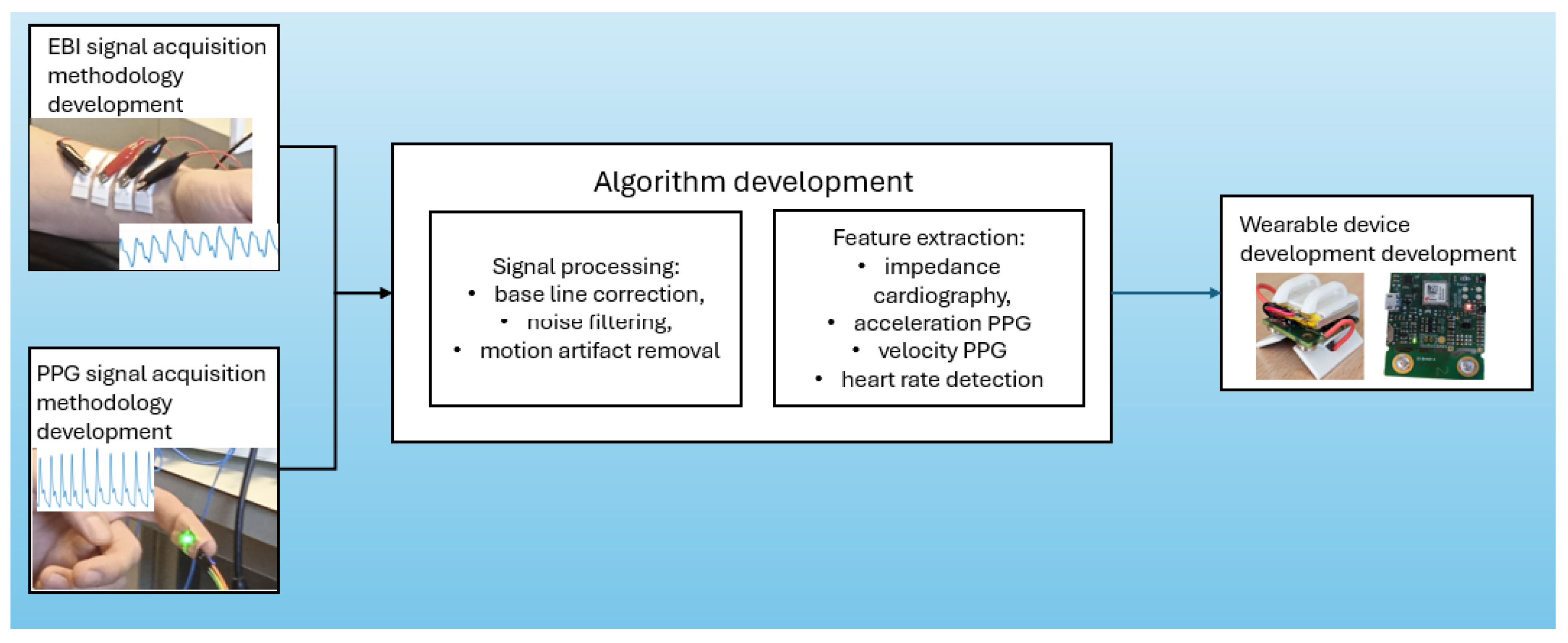
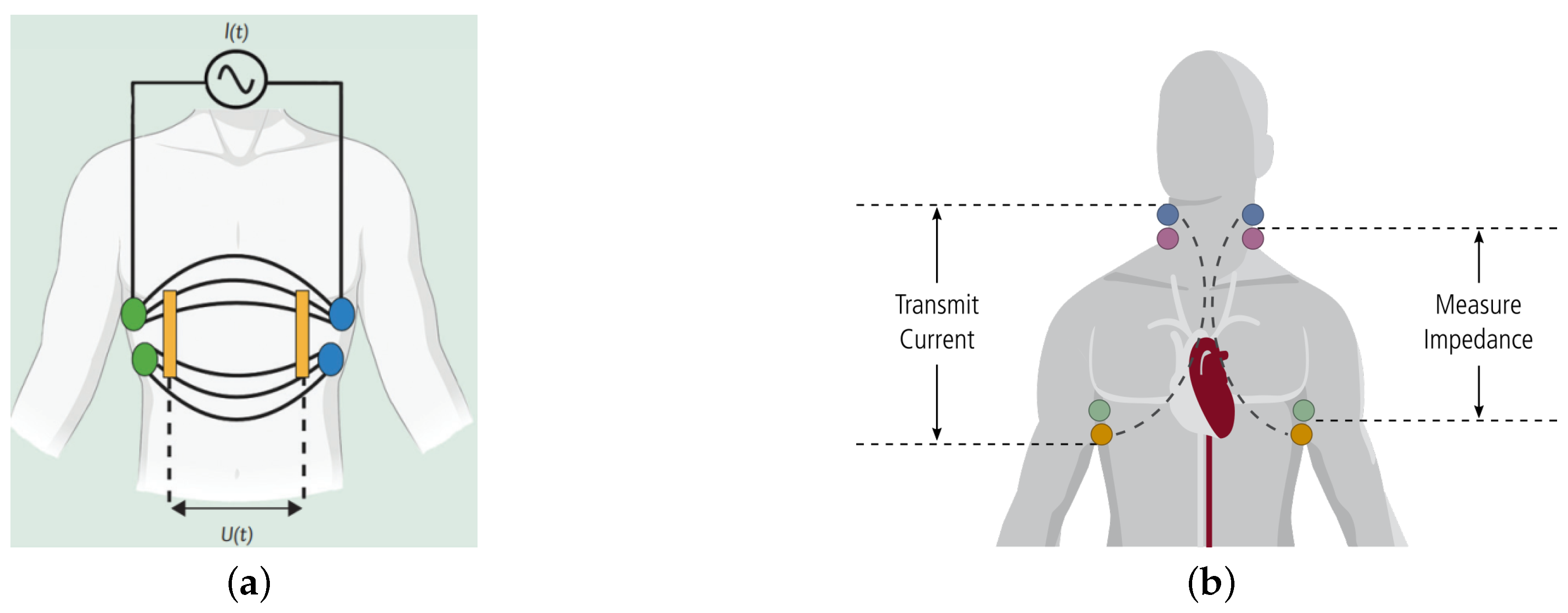
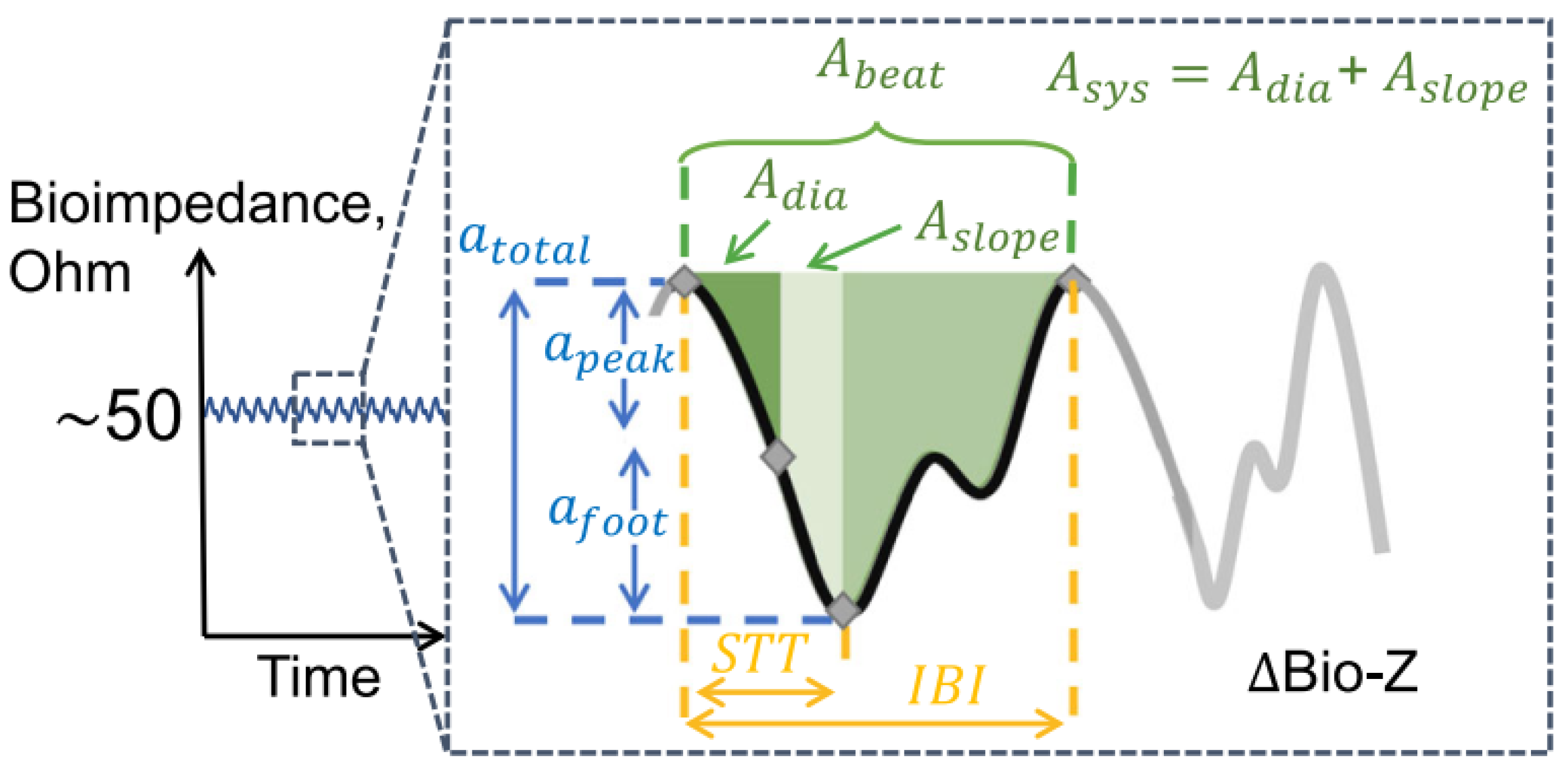
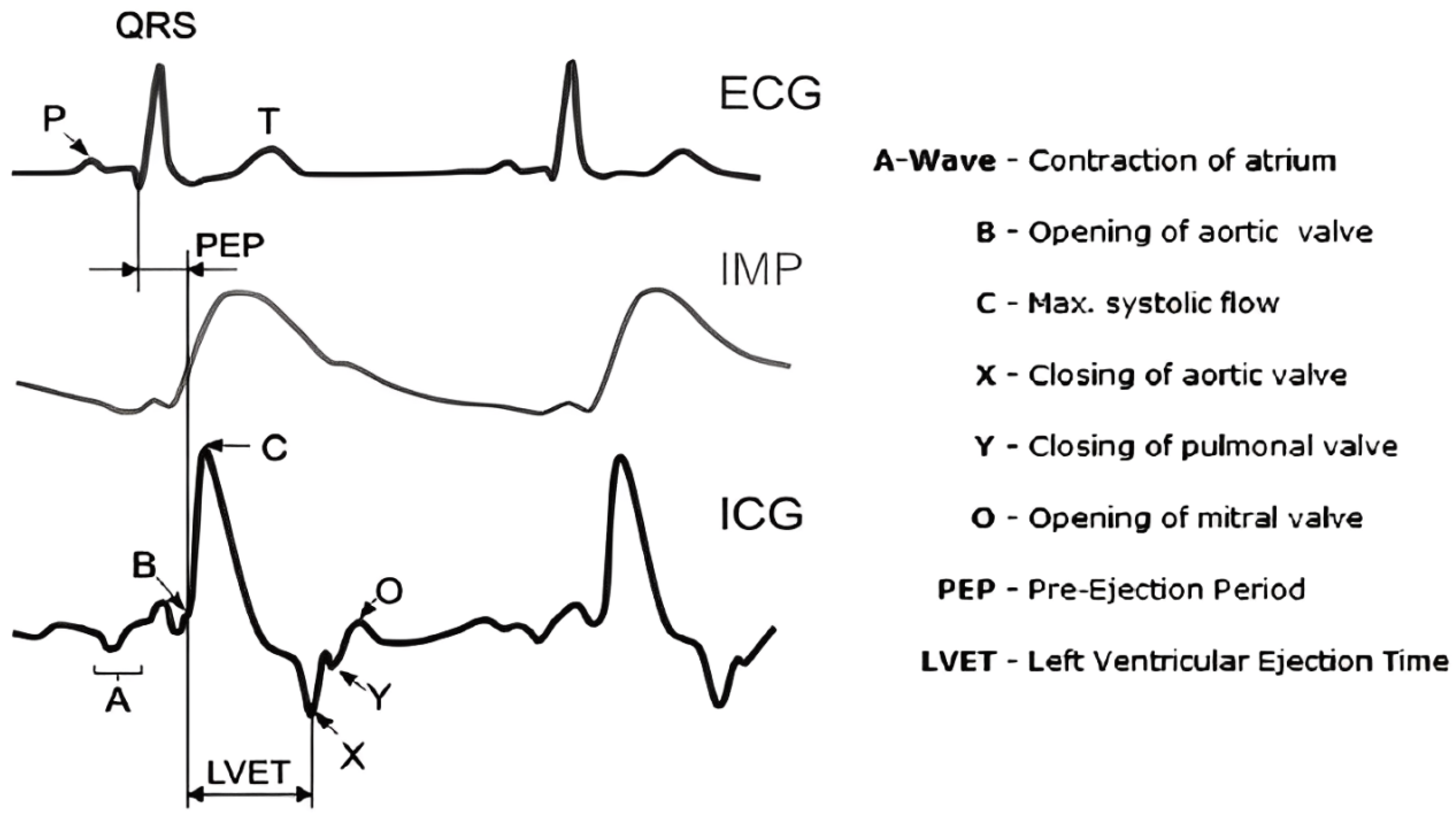
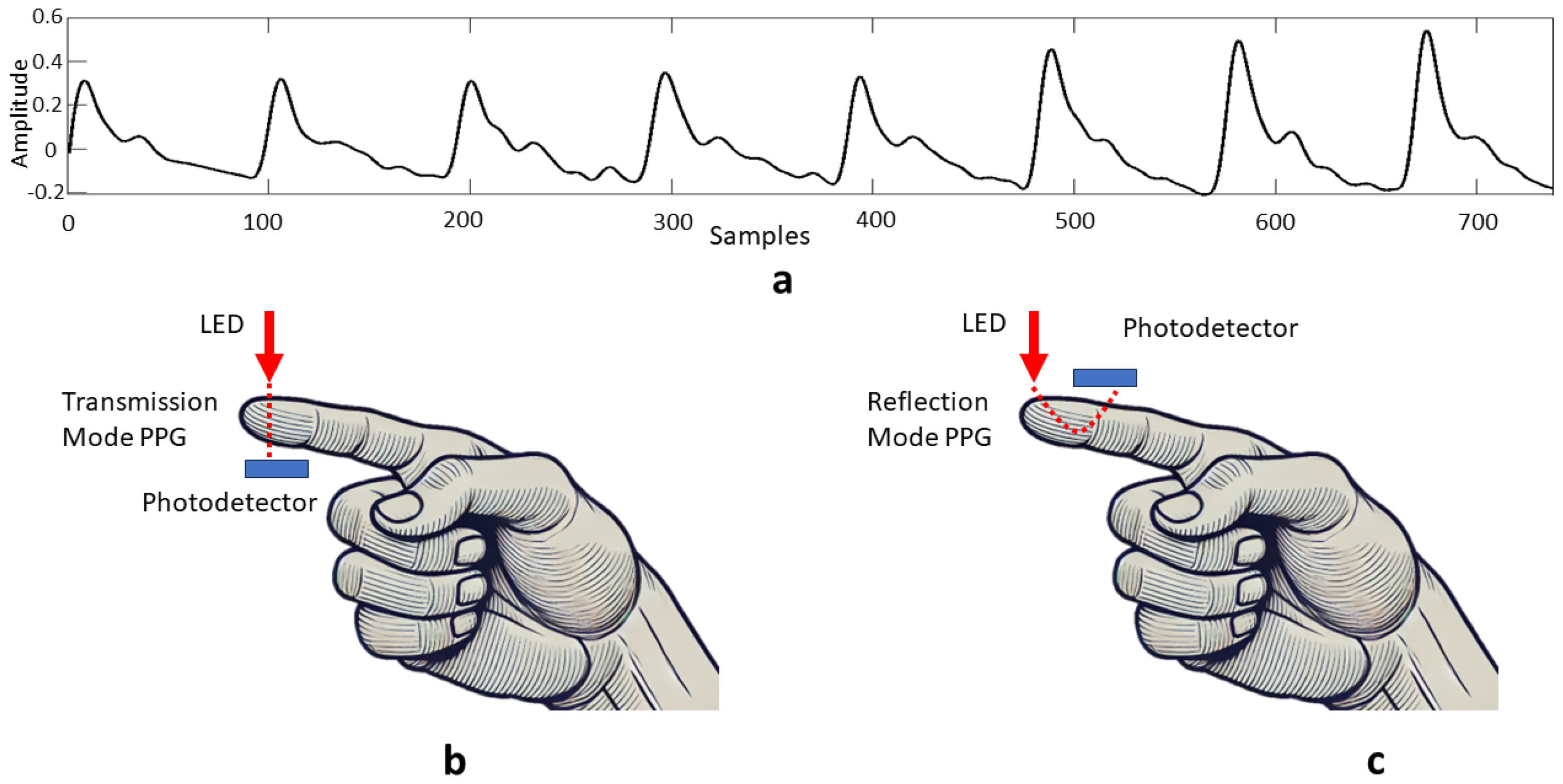
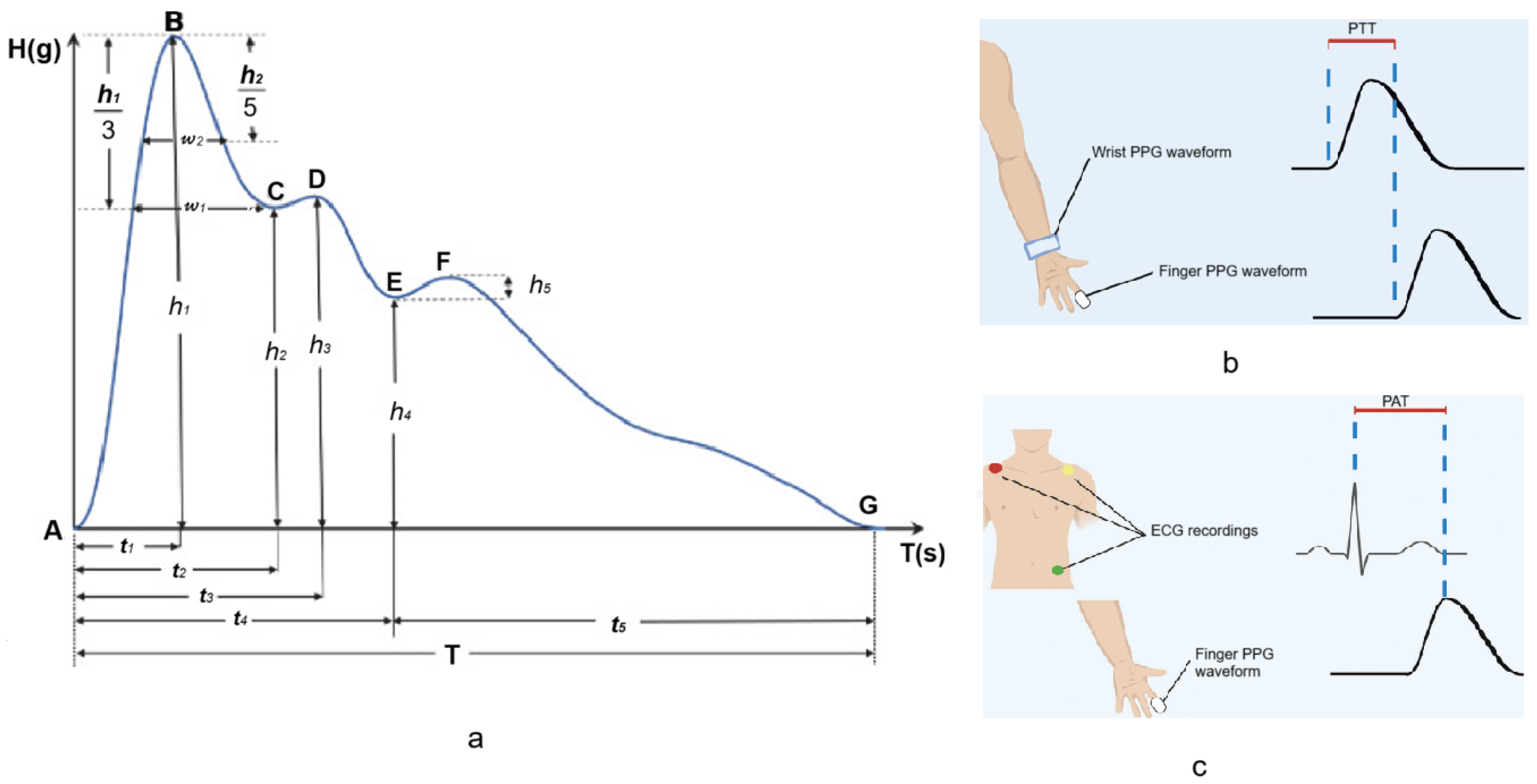



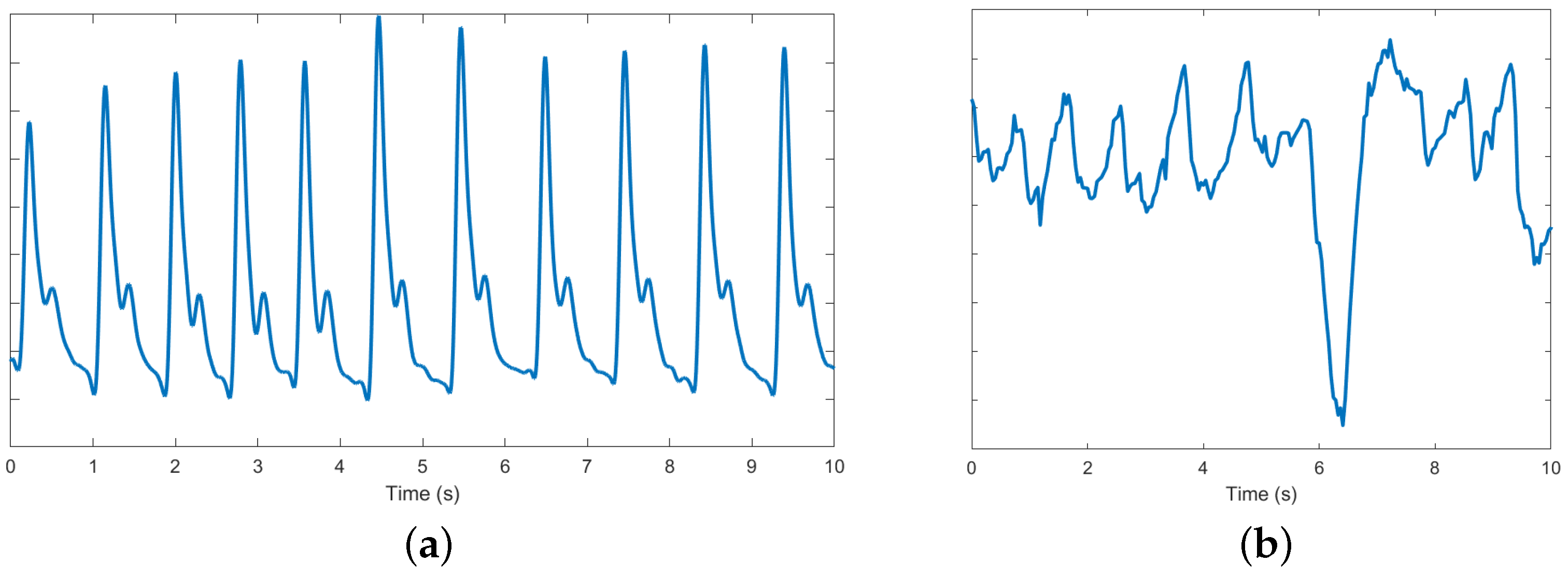
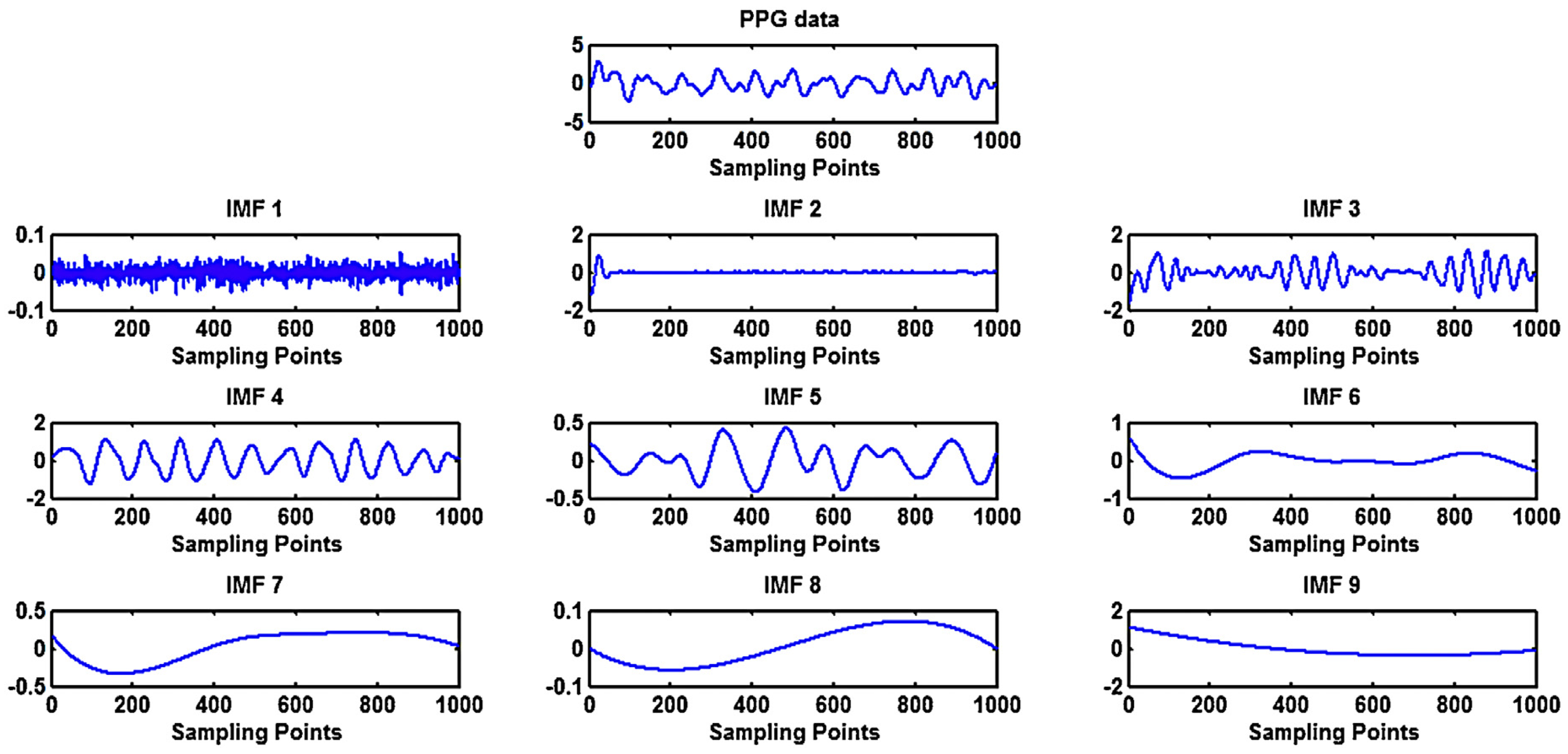
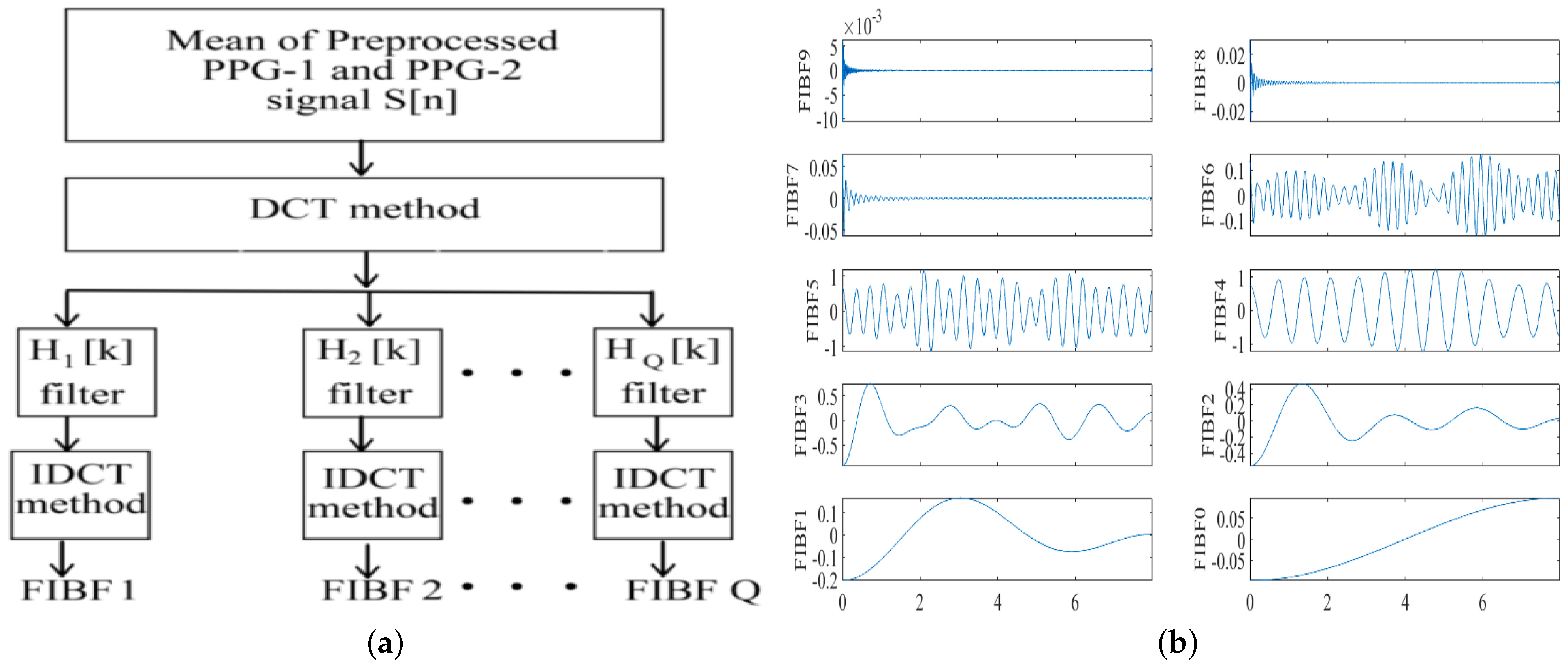
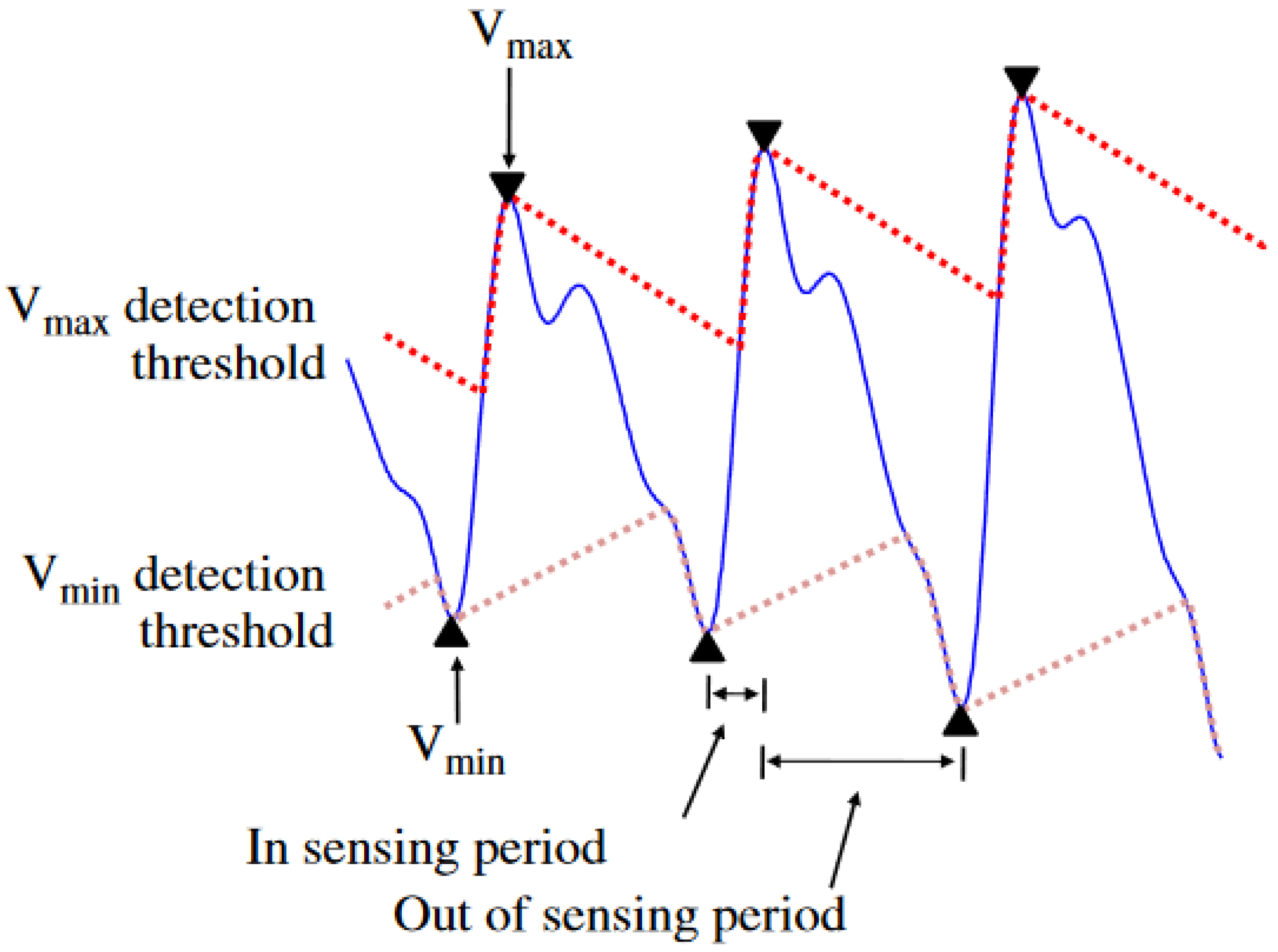
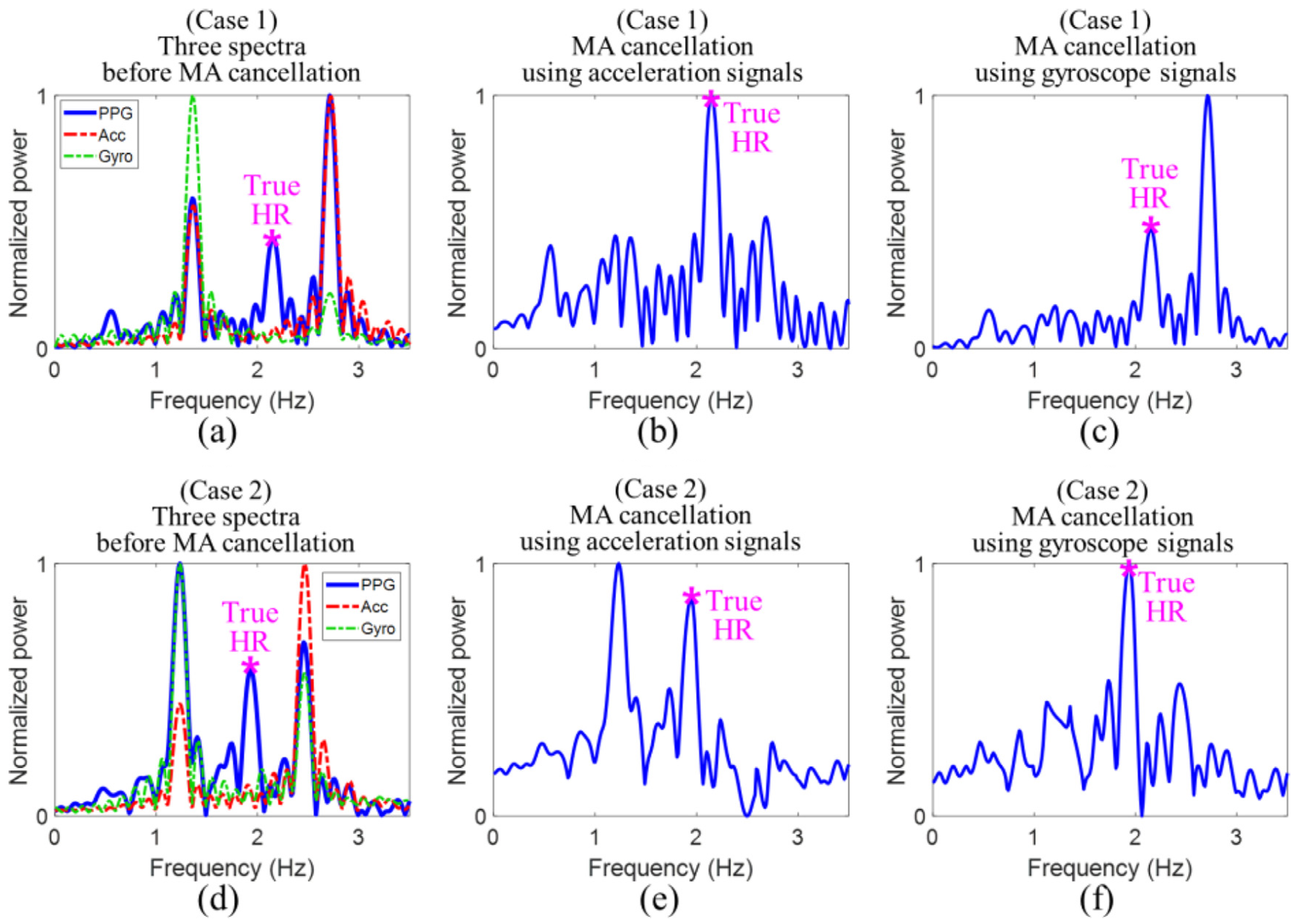


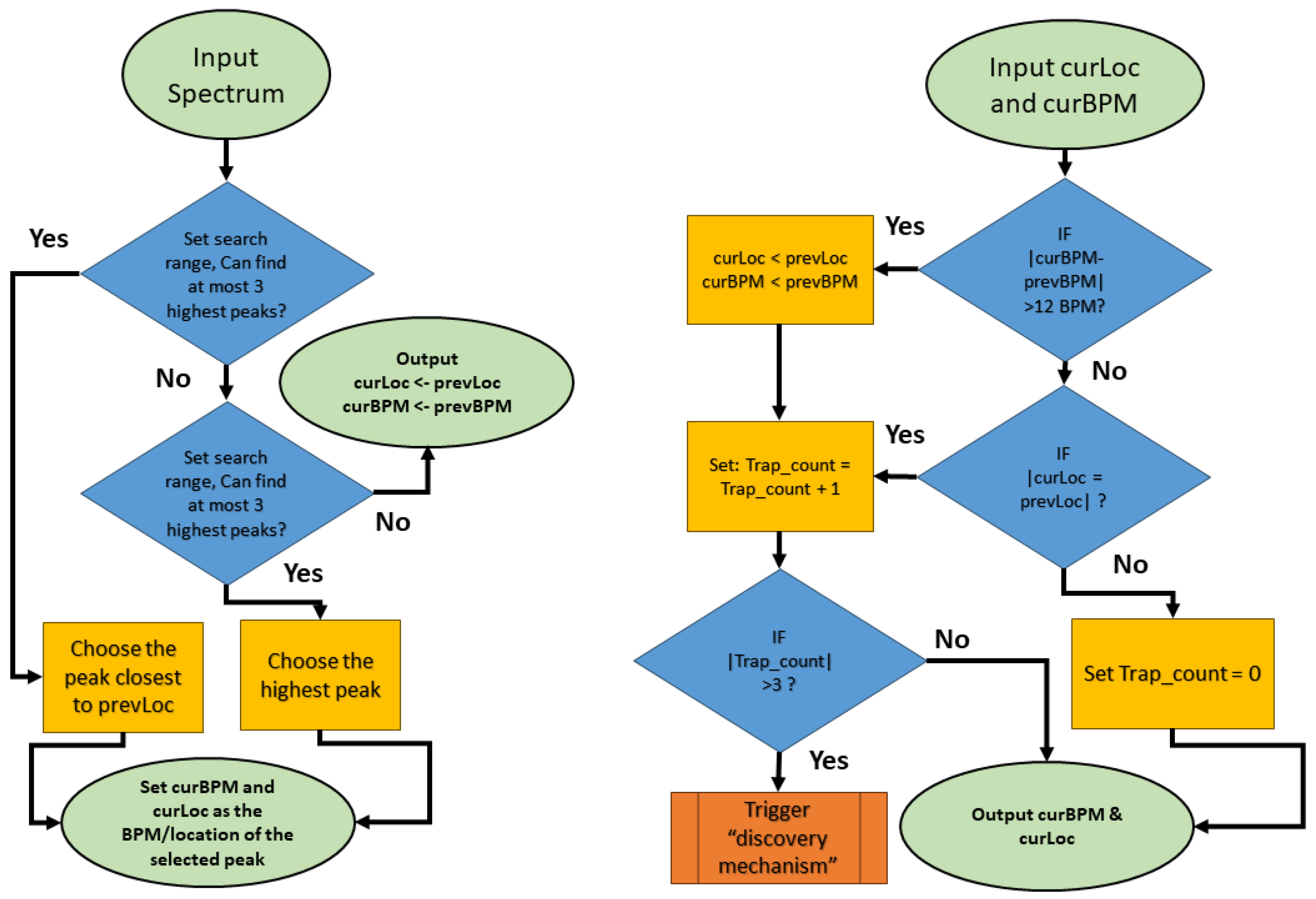
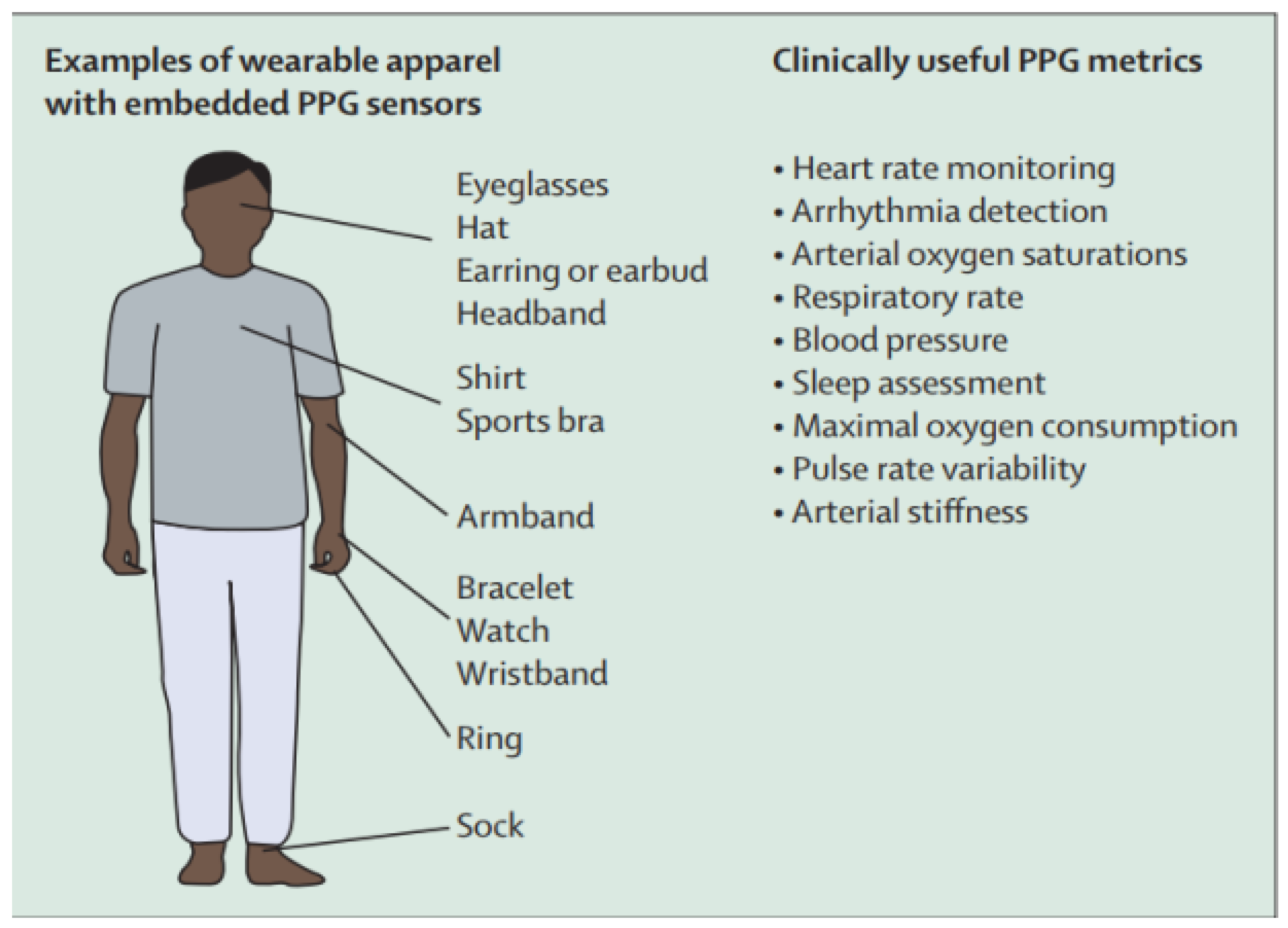

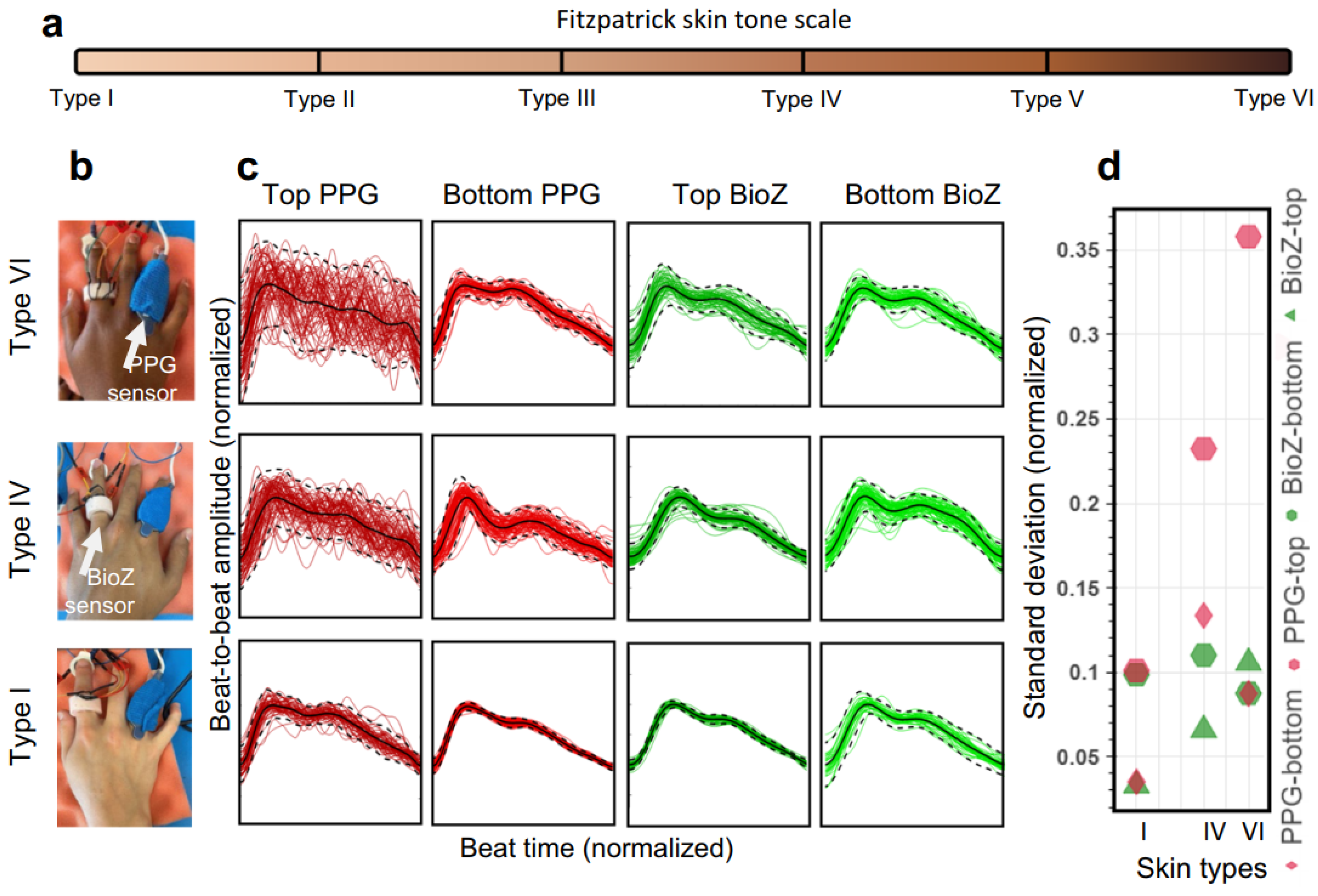
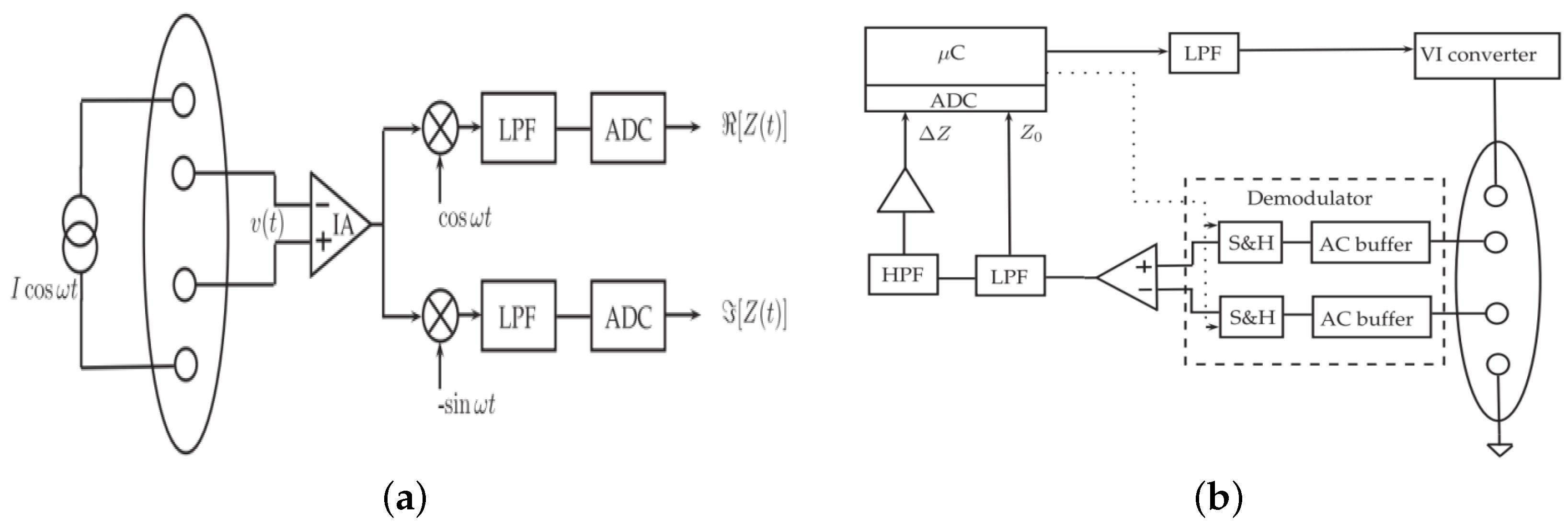
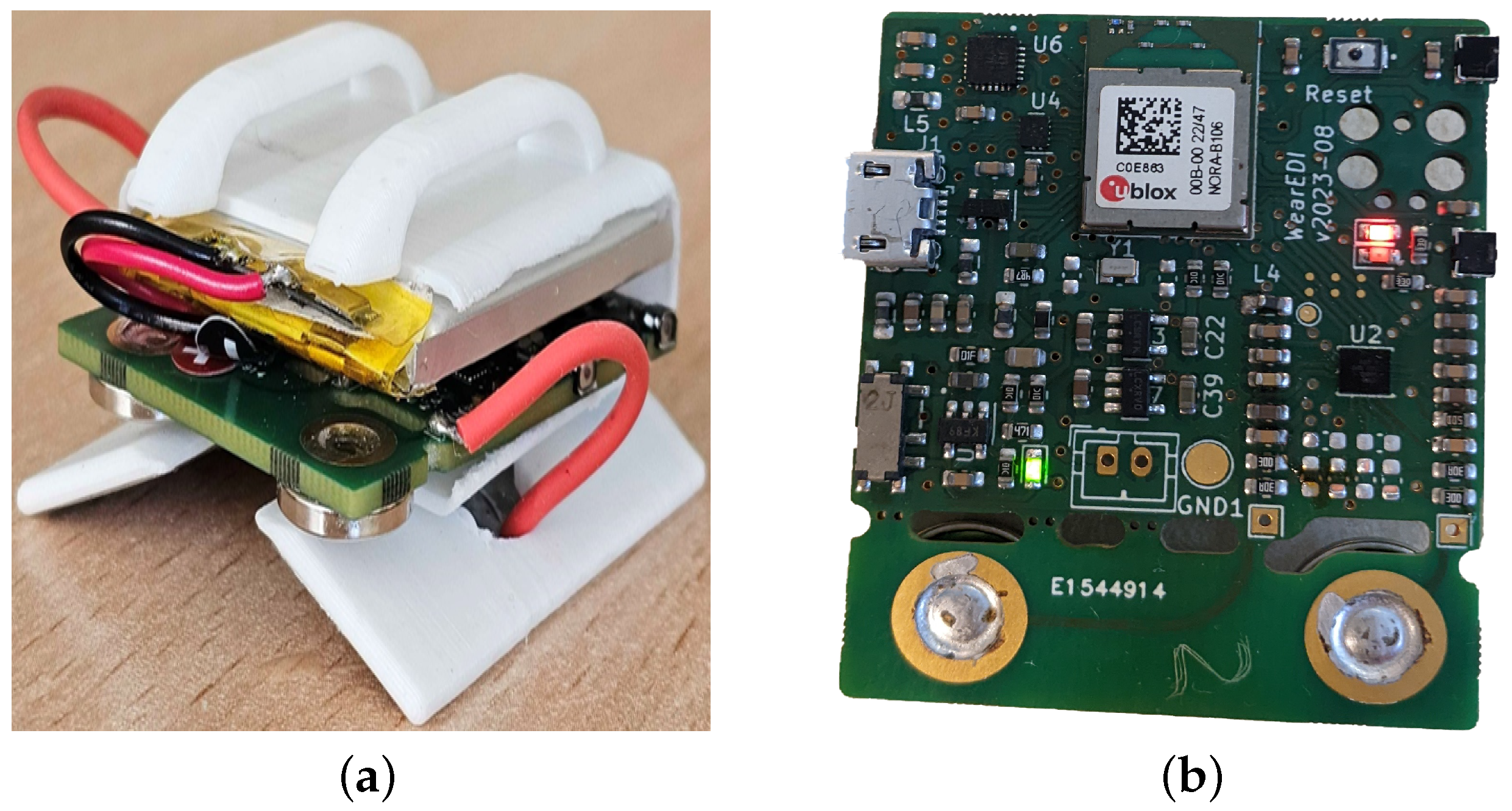
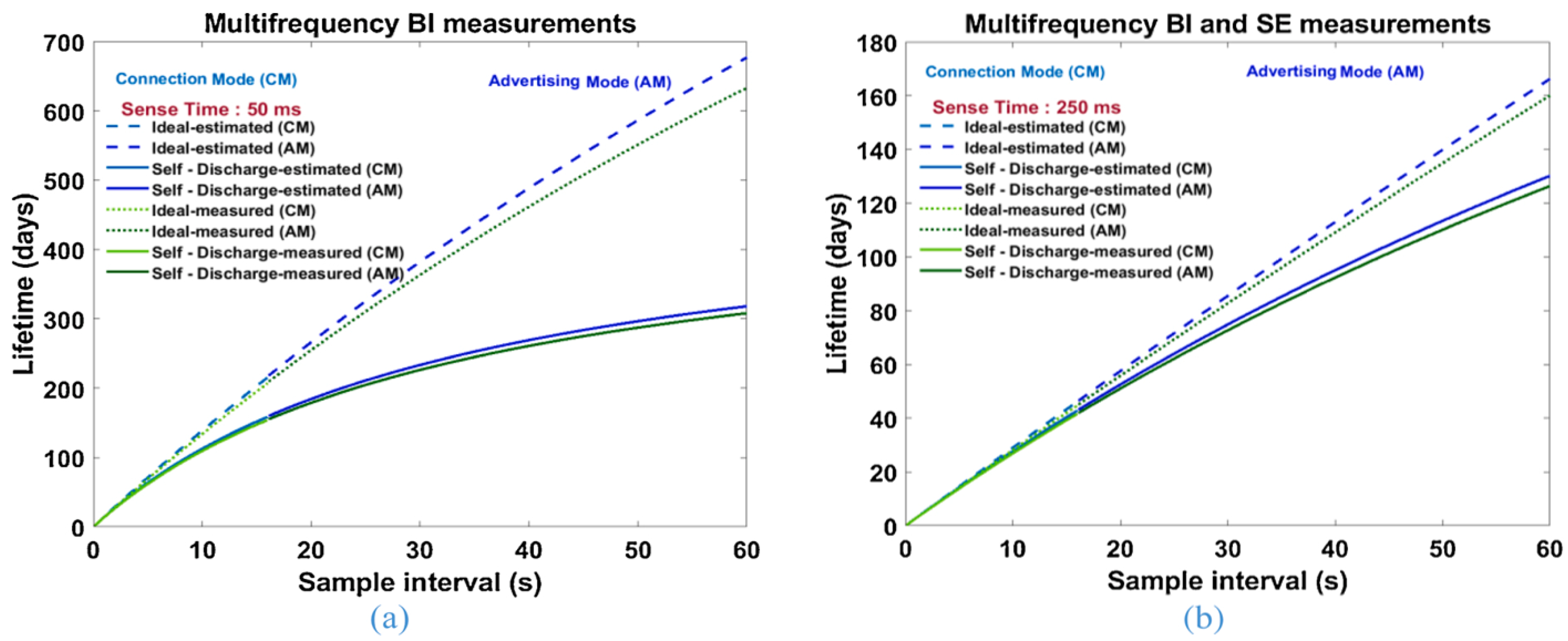
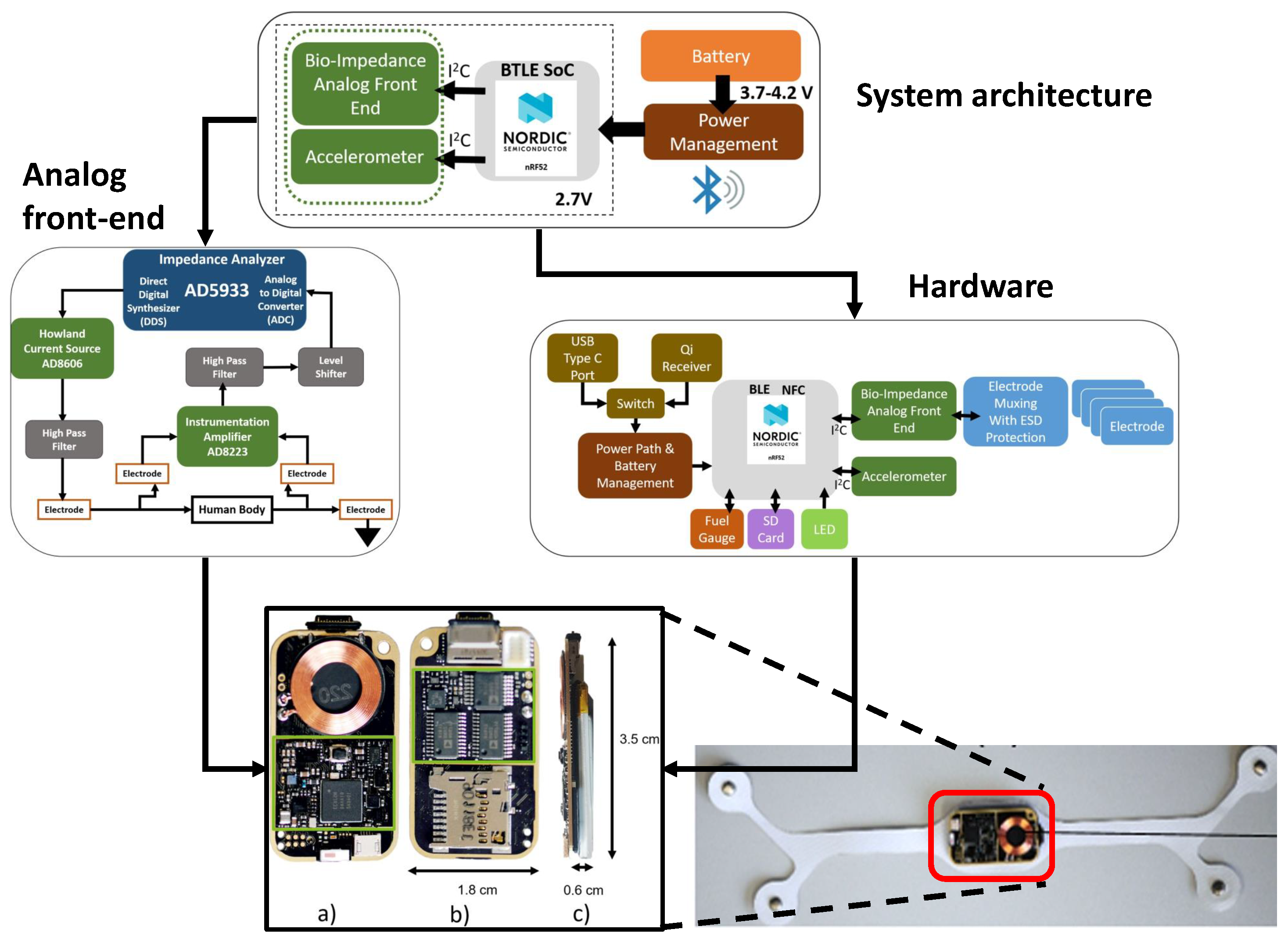
| Monitoring parameter | Heart rate variability | Blood pressure | Arterial stiffness |
| Cardiovascular risk factor | Arrhythmia | Hypertension causing heart attack and stroke | Hypertension, diabetes |
| Source | Specifications |
|---|---|
| [71] | PPG sensor—Reflective, Maxim MAX30101 + photodetector + 525 nm LED, sample rate 125 Hz; MIMU sensor—STMicroelectronics LSM9DS1, sample rate 125 Hz; Microcontroller—MCU: STMicroelectronics STM32L476; Analog-digital conversion—Analog Devices 7606 CE; Case dimensions—4.5 mm × 4.0 mm, 1.5 mm (resin, 3D printed); Circuit system—digital + analog for signal amplification and filtering; Signal transmission—wireless (2.4 GHz, Ashining: AS69-T20) |
| [72] | PPG sensor—Reflective, SFH 7070, Osram opto-semiconductors, Regensburg, Germany; IMU sensor—LSM6DSMTR, STMicroelectronics, Geneva, Switzerland; Analog-digital conversion—analog frontend MAX86141 (Maxim integrated, San Jose, CA, USA); Microcontroller—STM32F413CGU6, STMicroelectronics, Geneva, Swiss, clock rate 25 MHz; User interface—switch, 1.3 inch liquid crystal display (LCD, KWH013ST03-F01, FORMIKE, Shenzhen, China) |
| Device | Sensors | MCU | Dimensions (mm) | Apps |
|---|---|---|---|---|
| Apple Watch series 9 [132] | Electric Heat; PPG; Temp; Compass; Altimeter; ACC; Gyro; Ambient light; | S9-SiP-64-bit 4-core | 45 × 38 × 10.7 | ECG; Cycle Tracking with retrospective ovulation estimates; Heart Rate; High and low HR notifications; Irregular rhythm notifications; Medications; Mindfulness; Noise; Sleep, including sleep stages |
| Fitbit charge 5 [133] | 3-axis ACC; PPG; vibration motor;relative SpO2; ECG; EDA | Arm 32-bit Cortex M-4 | 36.7 × 22.7 × 11.2 | ECG; HR Monitoring: Continuously tracks HR; including irregular heart rhythm notifications and high and low HR notifications; Stress Detection: EDA-measure stress; Sleep Tracking; SpO2; Skin Temp; Health Metrics Dashboard; Exercise Tracking |
| Garmin fenix 6 pro [134] | PPG; BAROMETRIC ALTIMETER; GPS; COMPASS; Gyro; ACC; Term | NXP Kinetis | 47 × 47 × 14.7 | Wrist-based HR and Pulse Ox; Advanced Sleep Monitoring; Stress Tracking; Body Battery Energy Monitoring; Respiration Tracking; Hydration Tracking; Women’s Health Tracking; Performance Metrics; |
| Oura Ring gen3 [135] | IR, Green, Red LEDs; ACCs; NTC; Gyro | PSoC 6 BLE | - | Nighttime resting HR; HR variability; skin Temp; respiratory rate; Detailed sleep analysis; 24/7 HR tracking (Daytime, Nighttime, Workout); Integration with third-party health and wellness apps like Strava; Advanced Temp monitoring; SpO2; Cycle Insights; Pregnancy Insights; Daytime Stress; Resilience; Dynamic activity goals with Automatic Activity Detection; Weekly, monthly, quarterly, yearly, and anniversary reports |
| Whoop Band 4.0 [136] | ACC and Gyro; PPG; SpO2; Temp | Nordic nRF52840 SoC | 43 × 28 × 10 | Live HR; skin Temp; blood oxygen saturation; resting heart rate; HR variability; respiratory rate |
| Polar H10 Strip [137] | ECG; ACC | BLE | 34 × 65 × 10 | Full ECG chart; HR (HR), Average HR, Lowest HR, Peak HR; R - R; Calories |
| Firstbeat Sport Sensor [138] | ECG; ACC | BLE | 54 × 38 × 7.7 | HR (HR), Average HR, Lowest HR, Peak HR; Time in Highest Zone; Excess Post-Exercise Oxygen Consumption (EPOC); Training Impulse (TRIMP), TRIMP/min; Training Effect (aerobic, anaerobic) |
| Zephyr Bioharness 3 [139] | ECG; ACC; Temp; | BLE | 28 (Diam) × 7 | HR in beats per minute (BPM); Breathing Rate; Posture; Activity Level; Skin Temp; Peak Acceleration; Breathing Wave Amplitude; ECG Amplitude and Noise; HR RR Values |
| Source | Measurement Mode | Accuracy | Range () | Power Active | Power Sleep | Size (cm) | Sense Time (s) |
|---|---|---|---|---|---|---|---|
| [13] | MF | 1.5 % | 100–1000 | 53 mW | 15.7 W | 3 × 1.8 × 0.6 | 0.05 |
| [165] | MF | 0.5 | R < 54; 0.7< < 5 | 14.4 mW | 0.9 mW | 4.8 × 3 × 2 | - |
| [166] | SF | 0.1 % | 0–120 | 750 A at 2.8 V | - | - | - |
| [155] | MF | 4.5 % | 0–10,000 | 3 mA at 1.8 V | 8 A at 1.8 V | 4 × 4.6 × 1.3 | - |
Disclaimer/Publisher’s Note: The statements, opinions and data contained in all publications are solely those of the individual author(s) and contributor(s) and not of MDPI and/or the editor(s). MDPI and/or the editor(s) disclaim responsibility for any injury to people or property resulting from any ideas, methods, instructions or products referred to in the content. |
© 2024 by the authors. Licensee MDPI, Basel, Switzerland. This article is an open access article distributed under the terms and conditions of the Creative Commons Attribution (CC BY) license (https://creativecommons.org/licenses/by/4.0/).
Share and Cite
Lapsa, D.; Janeliukstis, R.; Metshein, M.; Selavo, L. PPG and Bioimpedance-Based Wearable Applications in Heart Rate Monitoring—A Comprehensive Review. Appl. Sci. 2024, 14, 7451. https://doi.org/10.3390/app14177451
Lapsa D, Janeliukstis R, Metshein M, Selavo L. PPG and Bioimpedance-Based Wearable Applications in Heart Rate Monitoring—A Comprehensive Review. Applied Sciences. 2024; 14(17):7451. https://doi.org/10.3390/app14177451
Chicago/Turabian StyleLapsa, Didzis, Rims Janeliukstis, Margus Metshein, and Leo Selavo. 2024. "PPG and Bioimpedance-Based Wearable Applications in Heart Rate Monitoring—A Comprehensive Review" Applied Sciences 14, no. 17: 7451. https://doi.org/10.3390/app14177451
APA StyleLapsa, D., Janeliukstis, R., Metshein, M., & Selavo, L. (2024). PPG and Bioimpedance-Based Wearable Applications in Heart Rate Monitoring—A Comprehensive Review. Applied Sciences, 14(17), 7451. https://doi.org/10.3390/app14177451









